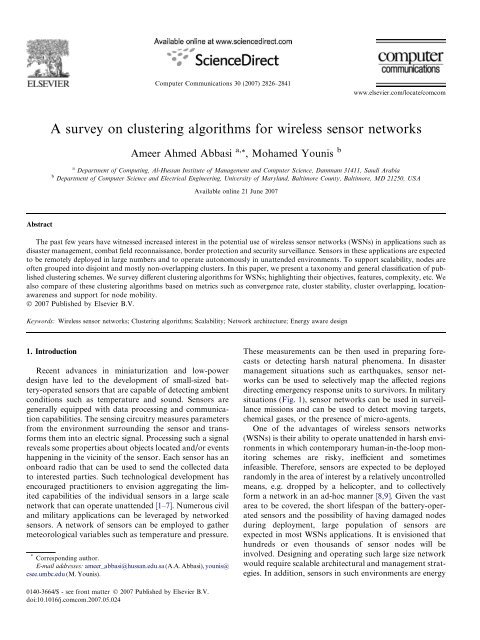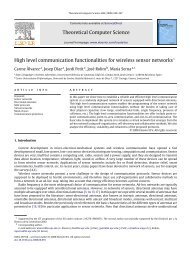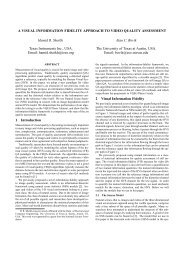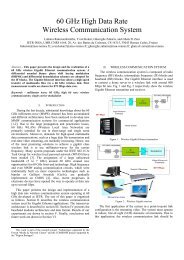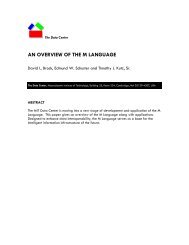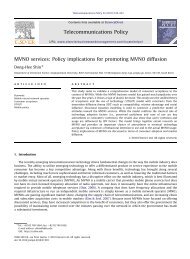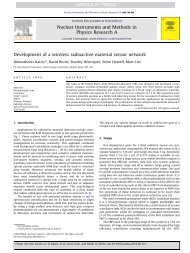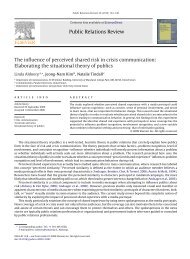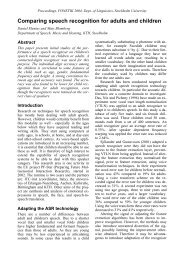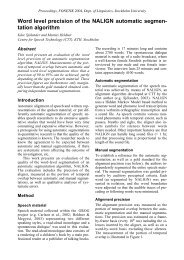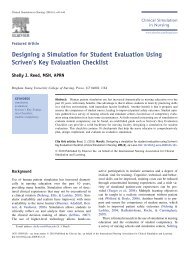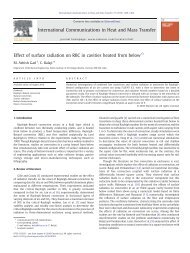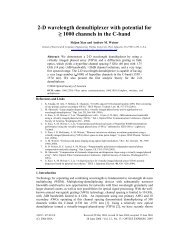A survey on clustering algorithms for wireless sensor networks
A survey on clustering algorithms for wireless sensor networks
A survey on clustering algorithms for wireless sensor networks
Create successful ePaper yourself
Turn your PDF publications into a flip-book with our unique Google optimized e-Paper software.
Abstract<br />
A <str<strong>on</strong>g>survey</str<strong>on</strong>g> <strong>on</strong> <strong>clustering</strong> <strong>algorithms</strong> <strong>for</strong> <strong>wireless</strong> <strong>sensor</strong> <strong>networks</strong><br />
Ameer Ahmed Abbasi a, *, Mohamed Younis b<br />
a Department of Computing, Al-Hussan Institute of Management and Computer Science, Dammam 31411, Saudi Arabia<br />
b Department of Computer Science and Electrical Engineering, University of Maryland, Baltimore County, Baltimore, MD 21250, USA<br />
Available <strong>on</strong>line 21 June 2007<br />
The past few years have witnessed increased interest in the potential use of <strong>wireless</strong> <strong>sensor</strong> <strong>networks</strong> (WSNs) in applicati<strong>on</strong>s such as<br />
disaster management, combat field rec<strong>on</strong>naissance, border protecti<strong>on</strong> and security surveillance. Sensors in these applicati<strong>on</strong>s are expected<br />
to be remotely deployed in large numbers and to operate aut<strong>on</strong>omously in unattended envir<strong>on</strong>ments. To support scalability, nodes are<br />
often grouped into disjoint and mostly n<strong>on</strong>-overlapping clusters. In this paper, we present a tax<strong>on</strong>omy and general classificati<strong>on</strong> of published<br />
<strong>clustering</strong> schemes. We <str<strong>on</strong>g>survey</str<strong>on</strong>g> different <strong>clustering</strong> <strong>algorithms</strong> <strong>for</strong> WSNs; highlighting their objectives, features, complexity, etc. We<br />
also compare of these <strong>clustering</strong> <strong>algorithms</strong> based <strong>on</strong> metrics such as c<strong>on</strong>vergence rate, cluster stability, cluster overlapping, locati<strong>on</strong>awareness<br />
and support <strong>for</strong> node mobility.<br />
Ó 2007 Published by Elsevier B.V.<br />
Keywords: Wireless <strong>sensor</strong> <strong>networks</strong>; Clustering <strong>algorithms</strong>; Scalability; Network architecture; Energy aware design<br />
1. Introducti<strong>on</strong><br />
Recent advances in miniaturizati<strong>on</strong> and low-power<br />
design have led to the development of small-sized battery-operated<br />
<strong>sensor</strong>s that are capable of detecting ambient<br />
c<strong>on</strong>diti<strong>on</strong>s such as temperature and sound. Sensors are<br />
generally equipped with data processing and communicati<strong>on</strong><br />
capabilities. The sensing circuitry measures parameters<br />
from the envir<strong>on</strong>ment surrounding the <strong>sensor</strong> and trans<strong>for</strong>ms<br />
them into an electric signal. Processing such a signal<br />
reveals some properties about objects located and/or events<br />
happening in the vicinity of the <strong>sensor</strong>. Each <strong>sensor</strong> has an<br />
<strong>on</strong>board radio that can be used to send the collected data<br />
to interested parties. Such technological development has<br />
encouraged practiti<strong>on</strong>ers to envisi<strong>on</strong> aggregating the limited<br />
capabilities of the individual <strong>sensor</strong>s in a large scale<br />
network that can operate unattended [1–7]. Numerous civil<br />
and military applicati<strong>on</strong>s can be leveraged by networked<br />
<strong>sensor</strong>s. A network of <strong>sensor</strong>s can be employed to gather<br />
meteorological variables such as temperature and pressure.<br />
0140-3664/$ - see fr<strong>on</strong>t matter Ó 2007 Published by Elsevier B.V.<br />
doi:10.1016/j.comcom.2007.05.024<br />
Computer Communicati<strong>on</strong>s 30 (2007) 2826–2841<br />
* Corresp<strong>on</strong>ding author.<br />
E-mail addresses: ameer_abbasi@hussan.edu.sa (A.A. Abbasi), younis@<br />
csee.umbc.edu (M. Younis).<br />
www.elsevier.com/locate/comcom<br />
These measurements can be then used in preparing <strong>for</strong>ecasts<br />
or detecting harsh natural phenomena. In disaster<br />
management situati<strong>on</strong>s such as earthquakes, <strong>sensor</strong> <strong>networks</strong><br />
can be used to selectively map the affected regi<strong>on</strong>s<br />
directing emergency resp<strong>on</strong>se units to survivors. In military<br />
situati<strong>on</strong>s (Fig. 1), <strong>sensor</strong> <strong>networks</strong> can be used in surveillance<br />
missi<strong>on</strong>s and can be used to detect moving targets,<br />
chemical gases, or the presence of micro-agents.<br />
One of the advantages of <strong>wireless</strong> <strong>sensor</strong>s <strong>networks</strong><br />
(WSNs) is their ability to operate unattended in harsh envir<strong>on</strong>ments<br />
in which c<strong>on</strong>temporary human-in-the-loop m<strong>on</strong>itoring<br />
schemes are risky, inefficient and sometimes<br />
infeasible. There<strong>for</strong>e, <strong>sensor</strong>s are expected to be deployed<br />
randomly in the area of interest by a relatively unc<strong>on</strong>trolled<br />
means, e.g. dropped by a helicopter, and to collectively<br />
<strong>for</strong>m a network in an ad-hoc manner [8,9]. Given the vast<br />
area to be covered, the short lifespan of the battery-operated<br />
<strong>sensor</strong>s and the possibility of having damaged nodes<br />
during deployment, large populati<strong>on</strong> of <strong>sensor</strong>s are<br />
expected in most WSNs applicati<strong>on</strong>s. It is envisi<strong>on</strong>ed that<br />
hundreds or even thousands of <strong>sensor</strong> nodes will be<br />
involved. Designing and operating such large size network<br />
would require scalable architectural and management strategies.<br />
In additi<strong>on</strong>, <strong>sensor</strong>s in such envir<strong>on</strong>ments are energy
Sensor nodes<br />
Base-stati<strong>on</strong><br />
Command Node<br />
Command Node<br />
Command<br />
Node<br />
Command Node<br />
Command<br />
Node<br />
Fig. 1. An articulati<strong>on</strong> of a sample WSN architecture <strong>for</strong> a military<br />
applicati<strong>on</strong>.<br />
c<strong>on</strong>strained and their batteries cannot be recharged. There<strong>for</strong>e,<br />
designing energy-aware <strong>algorithms</strong> becomes an<br />
important factor <strong>for</strong> extending the lifetime of <strong>sensor</strong>s.<br />
Other applicati<strong>on</strong> centric design objectives, e.g. high fidelity<br />
target detecti<strong>on</strong> and classificati<strong>on</strong>, are also c<strong>on</strong>sidered<br />
[10].<br />
Grouping <strong>sensor</strong> nodes into clusters has been widely pursued<br />
by the research community in order to achieve the network<br />
scalability objective. Every cluster would have a<br />
leader, often referred to as the cluster-head (CH). Although<br />
many <strong>clustering</strong> <strong>algorithms</strong> have been proposed in the literature<br />
<strong>for</strong> ad-hoc <strong>networks</strong> [11–15], the objective was mainly<br />
to generate stable clusters in envir<strong>on</strong>ments with mobile<br />
nodes. Many of such techniques care mostly about node<br />
reachability and route stability, without much c<strong>on</strong>cern<br />
about critical design goals of WSNs such as network l<strong>on</strong>gevity<br />
and coverage. Recently, a number of <strong>clustering</strong> <strong>algorithms</strong><br />
have been specifically designed <strong>for</strong> WSNs [16–20].<br />
These proposed <strong>clustering</strong> techniques widely vary depending<br />
<strong>on</strong> the node deployment and bootstrapping schemes, the<br />
pursued network architecture, the characteristics of the<br />
CH nodes and the network operati<strong>on</strong> model. A CH may<br />
be elected by the <strong>sensor</strong>s in a cluster or pre-assigned by the<br />
network designer. A CH may also be just <strong>on</strong>e of the <strong>sensor</strong>s<br />
or a node that is richer in resources. The cluster membership<br />
may be fixed or variable. CHs may <strong>for</strong>m a sec<strong>on</strong>d tier network<br />
or may just ship the data to interested parties, e.g. a<br />
base-stati<strong>on</strong> or a command center.<br />
In additi<strong>on</strong> to supporting network scalability, <strong>clustering</strong><br />
has numerous advantages. It can localize the route set up<br />
within the cluster and thus reduce the size of the routing<br />
table stored at the individual node [21]. Clustering can also<br />
c<strong>on</strong>serve communicati<strong>on</strong> bandwidth since it limits the<br />
scope of inter-cluster interacti<strong>on</strong>s to CHs and avoids<br />
redundant exchange of messages am<strong>on</strong>g <strong>sensor</strong> nodes<br />
[22]. Moreover, <strong>clustering</strong> can stabilize the network topology<br />
at the level of <strong>sensor</strong>s and thus cuts <strong>on</strong> topology maintenance<br />
overhead. Sensors would care <strong>on</strong>ly <strong>for</strong> c<strong>on</strong>necting<br />
A.A. Abbasi, M. Younis / Computer Communicati<strong>on</strong>s 30 (2007) 2826–2841 2827<br />
with their CHs and would not be affected by changes at the<br />
level of inter-CH tier [23]. The CH can also implement<br />
optimized management strategies to further enhance the<br />
network operati<strong>on</strong> and prol<strong>on</strong>g the battery life of the individual<br />
<strong>sensor</strong>s and the network lifetime [22]. A CH can<br />
schedule activities in the cluster so that nodes can switch<br />
to the low-power sleep mode most of the time and reduce<br />
the rate of energy c<strong>on</strong>sumpti<strong>on</strong>. Sensors can be engaged<br />
in a round-robin order and the time <strong>for</strong> their transmissi<strong>on</strong><br />
and recepti<strong>on</strong> can be determined so that the <strong>sensor</strong>s reties<br />
are avoided, redundancy in coverage can be limited and<br />
medium access collisi<strong>on</strong> is prevented [24–27]. Furthermore,<br />
a CH can aggregate the data collected by the <strong>sensor</strong>s in its<br />
cluster and thus decrease the number of relayed packets<br />
[28].<br />
In this paper, we opt to categorize <strong>clustering</strong> <strong>algorithms</strong><br />
proposed in the literature <strong>for</strong> WSNs. We report <strong>on</strong> the state<br />
of the research and summarize a collecti<strong>on</strong> of published<br />
schemes stating their features and shortcomings. We also<br />
compare the different approaches and analyze their applicability.<br />
In the next secti<strong>on</strong>, we discuss the different classificati<strong>on</strong>s<br />
of <strong>clustering</strong> techniques and enumerate a set of<br />
attributes <strong>for</strong> categorizing published <strong>algorithms</strong>. In Secti<strong>on</strong><br />
3, we summarize a collecti<strong>on</strong> of <strong>clustering</strong> <strong>algorithms</strong> <strong>for</strong><br />
WSNs and present classificati<strong>on</strong> of the various approaches<br />
pursued. Finally, Secti<strong>on</strong> 4 c<strong>on</strong>cludes the paper.<br />
2. Tax<strong>on</strong>omy of <strong>clustering</strong> attributes<br />
Clustering techniques <strong>for</strong> WSNs proposed in the literature<br />
can be generally classified based <strong>on</strong> the overall network<br />
architectural and operati<strong>on</strong> model and the objective<br />
of the node grouping process including the desired count<br />
and properties of the generated clusters. In this secti<strong>on</strong><br />
we discuss the different classificati<strong>on</strong>s and present tax<strong>on</strong>omy<br />
of a <strong>clustering</strong> attributes. We later use such attributes<br />
to categorize and compare the <str<strong>on</strong>g>survey</str<strong>on</strong>g>ed <strong>clustering</strong><br />
<strong>algorithms</strong>.<br />
2.1. Classifying <strong>clustering</strong> techniques<br />
2.1.1. Network model<br />
Different architectures and design goals/c<strong>on</strong>straints<br />
have been c<strong>on</strong>sidered <strong>for</strong> various applicati<strong>on</strong>s of WSNs.<br />
The following enlists some the relevant architectural<br />
parameters and highlight their implicati<strong>on</strong>s <strong>on</strong> network<br />
<strong>clustering</strong>.<br />
• Network dynamics: Basically WSNs c<strong>on</strong>sist of three<br />
main comp<strong>on</strong>ents: <strong>sensor</strong> nodes, base-stati<strong>on</strong> and m<strong>on</strong>itored<br />
events. Aside from the few setups that utilize mobile<br />
<strong>sensor</strong>s [29,30], most of the network architectures assume<br />
that <strong>sensor</strong> nodes are stati<strong>on</strong>ary [19,31,32]. Sometimes it<br />
is deemed necessary to support the mobility of base-stati<strong>on</strong><br />
or CHs. Node mobility would make <strong>clustering</strong> very challenging<br />
since the node membership will dynamically<br />
change, <strong>for</strong>cing clusters to evolve over time. On the other<br />
hand, the events m<strong>on</strong>itored by a <strong>sensor</strong> can be either
2828 A.A. Abbasi, M. Younis / Computer Communicati<strong>on</strong>s 30 (2007) 2826–2841<br />
intermittent or c<strong>on</strong>tinual depending <strong>on</strong> the applicati<strong>on</strong>. For<br />
instance, in a target detecti<strong>on</strong>/tracking applicati<strong>on</strong>, the<br />
event (phenomen<strong>on</strong>) is dynamic whereas <strong>for</strong>est m<strong>on</strong>itoring<br />
<strong>for</strong> early fire preventi<strong>on</strong> is an example of intermittent<br />
events. M<strong>on</strong>itoring intermittent events allows the network<br />
to work in a reactive mode, simply generating traffic when<br />
reporting. C<strong>on</strong>tinual events in most applicati<strong>on</strong>s require<br />
periodic reporting and c<strong>on</strong>sequently generate significant<br />
traffic to be routed to the sink. Although c<strong>on</strong>tinual events<br />
would mostly make the clusters stable, it may unevenly<br />
load CHs relative to the nodes in the cluster and a rotati<strong>on</strong><br />
of the CH role may be required if the CH is randomly<br />
picked from the <strong>sensor</strong> populati<strong>on</strong>. Intermittent events<br />
would favor adaptive <strong>clustering</strong> strategies if the number<br />
of events significantly fluctuates.<br />
• In-network data processing: Since <strong>sensor</strong> nodes might<br />
generate significant redundant data, similar packets from<br />
multiple nodes can be aggregated so that the number of<br />
transmissi<strong>on</strong>s would be reduced. Data aggregati<strong>on</strong> combines<br />
data from different sources by using functi<strong>on</strong>s such<br />
as suppressi<strong>on</strong> (eliminating duplicates), min, max and average<br />
[33]. Some of these functi<strong>on</strong>s can be per<strong>for</strong>med either<br />
partially or fully in each <strong>sensor</strong> node, by allowing <strong>sensor</strong><br />
nodes to c<strong>on</strong>duct in-network data reducti<strong>on</strong>. Recognizing<br />
that computati<strong>on</strong> would be less energy c<strong>on</strong>suming than<br />
communicati<strong>on</strong>, substantial energy savings can be obtained<br />
through data aggregati<strong>on</strong>. This technique has been used to<br />
achieve energy efficiency and traffic optimizati<strong>on</strong> in a number<br />
of routing protocols. In some network architectures, all<br />
aggregati<strong>on</strong> functi<strong>on</strong>s are assigned to more powerful and<br />
specialized nodes. Data aggregati<strong>on</strong> is also feasible through<br />
signal processing techniques. In that case, it is referred as<br />
data fusi<strong>on</strong> where a node is capable of producing a more<br />
accurate signal by reducing the noise and using some techniques<br />
such as beam<strong>for</strong>ming to combine the signals [20]. It<br />
will be intuitive to expect CHs to per<strong>for</strong>m such data aggregati<strong>on</strong>/fusi<strong>on</strong><br />
which may restrict the choice of CH to <strong>on</strong>ly<br />
specialized node or require limiting the number of <strong>sensor</strong>s<br />
per cluster in order to ensure that CHs are not overburdened<br />
[16]. It is worth noting that sometimes it may be necessary<br />
to assign backup CHs <strong>for</strong> a cluster or rotate the role<br />
of being CH am<strong>on</strong>g the <strong>sensor</strong>s in the cluster [20,34]. Obviously,<br />
such design choices/c<strong>on</strong>straints influence the <strong>clustering</strong><br />
scheme.<br />
• Node deployment and capabilities: Another c<strong>on</strong>siderati<strong>on</strong><br />
is the topological deployment of nodes. This is<br />
applicati<strong>on</strong> dependent and affects the need and objective<br />
of the network <strong>clustering</strong>. The deployment is either deterministic<br />
or self-organizing. In deterministic situati<strong>on</strong>s, the<br />
<strong>sensor</strong>s are manually placed and data is routed through<br />
pre-determined paths. There<strong>for</strong>e, <strong>clustering</strong> is such setup<br />
is also preset or unnecessary. However in self-organizing<br />
systems, the <strong>sensor</strong> nodes are scattered randomly creating<br />
an infrastructure in an ad hoc manner [8,19,20]. In that<br />
infrastructure, the positi<strong>on</strong> of the base-stati<strong>on</strong> or the<br />
CH is also crucial in terms of energy efficiency and per<strong>for</strong>mance.<br />
When the distributi<strong>on</strong> of nodes is not uni<strong>for</strong>m,<br />
optimal <strong>clustering</strong> becomes a pressing issue to enable<br />
energy efficient network operati<strong>on</strong>. In additi<strong>on</strong>, in some<br />
setups different functi<strong>on</strong>alities can be associated with the<br />
deployed nodes and the CH selecti<strong>on</strong> may be c<strong>on</strong>strained.<br />
In <strong>networks</strong> of homogenous <strong>sensor</strong> nodes, i.e. all having<br />
equal capacity in terms of computati<strong>on</strong>, communicati<strong>on</strong><br />
and power, CHs are picked from the deployed <strong>sensor</strong>s<br />
[20,35,36]. Often in that case, CHs are carefully tasked,<br />
e.g. excluded from sensing duties, in order to avoid<br />
depleting their energy rather quickly. In additi<strong>on</strong>, the<br />
communicati<strong>on</strong> range and the relative CH’s proximity<br />
to the base-stati<strong>on</strong> may also be c<strong>on</strong>straints/issues that<br />
have to be c<strong>on</strong>sidered. Sensors’ communicati<strong>on</strong> range is<br />
usually limited and a CH may not be able to reach the<br />
base-stati<strong>on</strong>. Even if a node can directly communicate<br />
with the base-stati<strong>on</strong>, it is still better to pursue multihop<br />
routes. There<strong>for</strong>e, inter-CH c<strong>on</strong>nectivity becomes an<br />
important factor that affects the <strong>clustering</strong> scheme<br />
[17,37]. On the other hand, heterogeneous WSNs may<br />
impose more c<strong>on</strong>straints <strong>on</strong> the <strong>clustering</strong> process since<br />
some nodes may be designated <strong>for</strong> special tasks or<br />
empowered with distinct capabilities. It may then be<br />
required to either avoid such specific nodes to c<strong>on</strong>serve<br />
their resources or limit the selecti<strong>on</strong> of CHs to a subset<br />
of these nodes.<br />
2.1.2. Clustering objectives<br />
Clustering <strong>algorithms</strong> in the literature varies in their<br />
objectives. Often the <strong>clustering</strong> objective is set in order to<br />
facilitate meeting the applicati<strong>on</strong>s requirements. For example<br />
if the applicati<strong>on</strong> is sensitive to data latency, intra and<br />
inter-cluster c<strong>on</strong>nectivity and the length of the data routing<br />
paths are usually c<strong>on</strong>sidered as criteria <strong>for</strong> CH selecti<strong>on</strong><br />
and node grouping. The following discussi<strong>on</strong> highlights<br />
popular objectives <strong>for</strong> network <strong>clustering</strong>:<br />
• Load balancing: Even distributi<strong>on</strong> of <strong>sensor</strong>s am<strong>on</strong>g<br />
the clusters is usually an objective <strong>for</strong> setups where CHs<br />
per<strong>for</strong>m data processing or significant intra-cluster management<br />
duties [16]. Given the duties of CHs, it is intuitive<br />
to balance the load am<strong>on</strong>g them so that they can meet the<br />
expected per<strong>for</strong>mance goals [38]. Load balancing is a more<br />
pressing issue in WSNs where CHs are picked from the<br />
available <strong>sensor</strong>s [19]. In such case, setting equal-sized clusters<br />
becomes crucial <strong>for</strong> extending the network lifetime<br />
since it prevents the exhausti<strong>on</strong> of the energy of a subset<br />
of CHs at high rate and prematurely making them dysfuncti<strong>on</strong>al.<br />
Even distributi<strong>on</strong> of <strong>sensor</strong>s can also leverage data<br />
delay [37]. When CHs per<strong>for</strong>m data aggregati<strong>on</strong>, it is<br />
imperative to have similar number of node in the clusters<br />
so that the combined data report becomes ready almost<br />
at the same time <strong>for</strong> further processing at the base-stati<strong>on</strong><br />
or at the next tier in the network.<br />
• Fault-tolerance: In many applicati<strong>on</strong>s, WSNs will be<br />
operati<strong>on</strong>al in harsh envir<strong>on</strong>ments and thus nodes are usually<br />
exposed to increased risk of malfuncti<strong>on</strong> and physical<br />
damage. Tolerating the failure of CHs is usually necessary<br />
in such applicati<strong>on</strong>s in order to avoid the loss of important
<strong>sensor</strong>s’ data. The most intuitive way to recover from a CH<br />
failure is to re-cluster the network. However, re-<strong>clustering</strong> is<br />
not <strong>on</strong>ly a resource burden <strong>on</strong> the nodes, it is often very disruptive<br />
to the <strong>on</strong>-going operati<strong>on</strong>. There<strong>for</strong>e, c<strong>on</strong>temporary<br />
fault-tolerance techniques would be more appropriate <strong>for</strong><br />
that sake. Assigning backup CHs is the most notable scheme<br />
pursued in the literature <strong>for</strong> recovery from a CH failure. The<br />
selecti<strong>on</strong> of a backup and the role such spare CH will play<br />
during normal network operati<strong>on</strong> varies. When CHs have<br />
l<strong>on</strong>g radio range, neighboring CHs can adapt the <strong>sensor</strong>s<br />
in the failing cluster [34]. Rotating the role of CHs am<strong>on</strong>g<br />
nodes in the cluster can also be a means <strong>for</strong> fault-tolerance<br />
in additi<strong>on</strong> to their load balancing advantage [20].<br />
• Increased c<strong>on</strong>nectivity and reduced delay: Unless CHs<br />
have very l<strong>on</strong>g-haul communicati<strong>on</strong> capabilities, e.g. a<br />
satellite link, inter-CH c<strong>on</strong>nectivity is an important<br />
requirement in many applicati<strong>on</strong>s. This is particularly<br />
true when CHs are picked from the <strong>sensor</strong>s populati<strong>on</strong>.<br />
The c<strong>on</strong>nectivity goal can be just limited to ensuring<br />
the availability of a path from every CH to the base-stati<strong>on</strong><br />
[17] or be more restrictive by imposing a bound <strong>on</strong><br />
the length of the path [40]. When some of the <strong>sensor</strong>s<br />
assume the CH role, the c<strong>on</strong>nectivity objective makes<br />
network <strong>clustering</strong> <strong>on</strong>e of the many variant of the c<strong>on</strong>nected<br />
dominating set problem. On the other hand, when<br />
data latency is a c<strong>on</strong>cern, intra-cluster c<strong>on</strong>nectivity<br />
becomes a design objective or c<strong>on</strong>straint. Delay is usually<br />
factored in by setting a maximum number of hops ‘‘K’’<br />
allowed <strong>on</strong> a data path. K-hop <strong>clustering</strong> is K-dominating<br />
set problem [41–43].<br />
• Minimal cluster count: This objective is particularly<br />
comm<strong>on</strong> when CHs are specialized resource-rich nodes<br />
[39]. The network designer often likes to employ the least<br />
number of these nodes since they tend to be more expensive<br />
and vulnerable than <strong>sensor</strong>s. For example, if CHs are laptop<br />
computers, robots or a mobile vehicle there will be<br />
inherently some limitati<strong>on</strong> <strong>on</strong> the number of nodes. The<br />
limitati<strong>on</strong> can be due to the complexity of deploying these<br />
types of nodes, e.g. when the WSN is to operate in a combat<br />
z<strong>on</strong>e or a <strong>for</strong>est. In additi<strong>on</strong>, the size of these nodes<br />
tends to be significantly larger than <strong>sensor</strong>s, which makes<br />
them easily detectable. Node visibility is highly undesirable<br />
in many WSNs applicati<strong>on</strong>s such as border protecti<strong>on</strong>, military<br />
rec<strong>on</strong>naissance and infrastructure security.<br />
• Maximal network l<strong>on</strong>gevity: Since <strong>sensor</strong> nodes are<br />
energy-c<strong>on</strong>strained, the network’s lifetime is a major c<strong>on</strong>cern;<br />
especially <strong>for</strong> applicati<strong>on</strong>s of WSNs in harsh envir<strong>on</strong>ments.<br />
When CHs are richer in resources than <strong>sensor</strong>s, it is<br />
imperative to minimize the energy <strong>for</strong> intra-cluster communicati<strong>on</strong><br />
[22]. If possible, CHs should be placed close to<br />
most of the <strong>sensor</strong>s in its clusters [39,44]. On the other<br />
hand, when CHs are regular <strong>sensor</strong>s, their lifetime can be<br />
extended by limiting their load as we menti<strong>on</strong>ed earlier.<br />
Combined <strong>clustering</strong> and route setup has also been c<strong>on</strong>sidered<br />
<strong>for</strong> maximizing network’s lifetime [45]. Adaptive <strong>clustering</strong><br />
is also a viable choice <strong>for</strong> achieving network<br />
l<strong>on</strong>gevity [46,47].<br />
A.A. Abbasi, M. Younis / Computer Communicati<strong>on</strong>s 30 (2007) 2826–2841 2829<br />
2.1.3. Tax<strong>on</strong>omy of <strong>clustering</strong> attributes<br />
In this secti<strong>on</strong> we opt to enumerate the set of attributes<br />
that can be use to categorizes and differentiate <strong>clustering</strong><br />
<strong>algorithms</strong> of WSNs. Based <strong>on</strong> the discussi<strong>on</strong> above, we<br />
can identify the following attributes:<br />
1. Cluster properties: Often <strong>clustering</strong> schemes strive to<br />
achieve some characteristics <strong>for</strong> the generated clusters.<br />
Such characteristics can be related to the internal structure<br />
of the cluster or how it relates to others. The following<br />
are the relevant attributes:<br />
• Cluster count: In some published approaches the set of<br />
CHs are predetermined and thus the number of clusters<br />
are preset. Randomly picking CHs from the deployed<br />
<strong>sensor</strong>s usually yields variable number of clusters.<br />
• Stability: When the clusters count varies and the<br />
node’s membership evolves overtime, the <strong>clustering</strong><br />
scheme is said to be adaptive. Otherwise, it is c<strong>on</strong>sidered<br />
fixed since <strong>sensor</strong>s do not switch am<strong>on</strong>g clusters<br />
and the number of clusters stays the same throughout<br />
the network lifespan.<br />
• Intra-cluster topology: Some <strong>clustering</strong> schemes are<br />
based <strong>on</strong> direct communicati<strong>on</strong> between a <strong>sensor</strong> and<br />
its designated CH. However, multi-hop <strong>sensor</strong>-to-CH<br />
c<strong>on</strong>nectivity is sometimes required; especially when the<br />
<strong>sensor</strong>’s communicati<strong>on</strong> range is limited and/or the<br />
CH count is bounded.<br />
• Inter-CH c<strong>on</strong>nectivity: When the CH does not have l<strong>on</strong>g<br />
haul communicati<strong>on</strong> capabilities, CHs c<strong>on</strong>nectivity to<br />
the base-stati<strong>on</strong> has to be provisi<strong>on</strong>ed. In that case,<br />
the <strong>clustering</strong> scheme has to ensure the feasibility of<br />
establishing an inter-CH route from every CH to the<br />
base-stati<strong>on</strong>. Some of the published work assumes that<br />
CH would be able to directly reach the base-stati<strong>on</strong>.<br />
2. Cluster-head capabilities: As discussed earlier the<br />
network model influences the <strong>clustering</strong> approach; particularly<br />
the node capabilities and the scope of the innetwork<br />
processing. The following attributes of the<br />
CH node are differentiating factors am<strong>on</strong>g <strong>clustering</strong><br />
schemes:<br />
• Mobility: When a CH is mobile, <strong>sensor</strong>’s membership<br />
dynamically changes and the clusters would need to be<br />
c<strong>on</strong>tinuously maintained. On the other hand, stati<strong>on</strong>ary<br />
CH tends to yield stable clusters and facilitate<br />
intra- and inter-cluster network management. Sometimes,<br />
CHs can travel <strong>for</strong> limited distances to repositi<strong>on</strong><br />
itself <strong>for</strong> better network per<strong>for</strong>mance.<br />
• Node types: As indicated earlier, in some setups a<br />
subset of the deployed <strong>sensor</strong>s are designated as CHs<br />
while in others CHs are equipped with significantly<br />
more computati<strong>on</strong> and communicati<strong>on</strong> resources.<br />
• Role: A CH can simply act as a relay <strong>for</strong> the traffic<br />
generated by the <strong>sensor</strong>s in its cluster or per<strong>for</strong>m aggregati<strong>on</strong>/fusi<strong>on</strong><br />
of collected <strong>sensor</strong>s’ data. Sometime,<br />
a CH acts as a sink or a base-stati<strong>on</strong> that takes acti<strong>on</strong>s<br />
based <strong>on</strong> the detected phenomena or targets.
2830 A.A. Abbasi, M. Younis / Computer Communicati<strong>on</strong>s 30 (2007) 2826–2841<br />
3. Clustering process: The coordinati<strong>on</strong> of the entire <strong>clustering</strong><br />
process and the characteristics of the <strong>algorithms</strong><br />
vary significantly am<strong>on</strong>g published <strong>clustering</strong> schemes.<br />
The following attributes are deemed relevant:<br />
• Methodology: When CHs are just regular <strong>sensor</strong>s<br />
nodes, <strong>clustering</strong> has to be per<strong>for</strong>med in a distributed<br />
manner without coordinati<strong>on</strong>. In few approaches, a<br />
centralized authority partiti<strong>on</strong>s the nodes offline and<br />
c<strong>on</strong>trols the cluster membership. Hybrid schemes can<br />
also be found; especially when CHs are rich in<br />
resources. In the later case, inter-CHs coordinati<strong>on</strong> is<br />
per<strong>for</strong>med in a distributed manner, while each individual<br />
CH takes charge of <strong>for</strong>ming its own cluster.<br />
• Objective of node grouping: As discussed in the previous<br />
secti<strong>on</strong>, several objectives have been pursued <strong>for</strong><br />
<strong>for</strong>ming clusters. Examples include fault-tolerance,<br />
load balancing, network c<strong>on</strong>nectivity, etc.<br />
• Cluster-head selecti<strong>on</strong>: CHs can be pre-assigned or<br />
picked randomly from the deployed set of nodes.<br />
• Algorithm complexity: Depending <strong>on</strong> the objective and<br />
the methodology, numerous <strong>clustering</strong> <strong>algorithms</strong><br />
have been proposed. The complexity and c<strong>on</strong>vergence<br />
rate of these <strong>algorithms</strong> can be c<strong>on</strong>stant or dependent<br />
<strong>on</strong> the number of CHs and/or <strong>sensor</strong>s.<br />
We would like to note that some of these attributes are<br />
mutually exclusive, e.g. preset or variable cluster count,<br />
and some are not. For example, a <strong>clustering</strong> process may<br />
have multiple objectives. It is also worth noting that network<br />
<strong>clustering</strong> can influence or be influenced by the<br />
planned network and link layer protocols. We plan to hint<br />
<strong>on</strong> the implicati<strong>on</strong>s of routing and MAC protocols when<br />
we summarize the published <strong>clustering</strong> schemes. Fig. 2<br />
summarizes the presented tax<strong>on</strong>omy of attributes. We use<br />
this set of attributes in categorizing the <strong>clustering</strong> <strong>algorithms</strong><br />
summarized in the next secti<strong>on</strong>.<br />
3. Clustering <strong>algorithms</strong> <strong>for</strong> WSNs<br />
Generally, WSNs involve a large number of <strong>sensor</strong>s ranging<br />
in the hundreds or even thousands. Clustering is an effective<br />
mean <strong>for</strong> managing such high populati<strong>on</strong> of nodes. In<br />
this secti<strong>on</strong> we present a literature <str<strong>on</strong>g>survey</str<strong>on</strong>g> of published distributed<br />
<strong>algorithms</strong> <strong>for</strong> <strong>clustering</strong> WSNs. Given that scalability<br />
is regarded as the main advantage of network<br />
<strong>clustering</strong>, the <str<strong>on</strong>g>survey</str<strong>on</strong>g>ed <strong>algorithms</strong> are grouped according<br />
to their c<strong>on</strong>vergence rate into two subsecti<strong>on</strong>s <strong>for</strong> variable<br />
and c<strong>on</strong>stant c<strong>on</strong>vergence time <strong>algorithms</strong>, respectively.<br />
3.1. Variable c<strong>on</strong>vergence time <strong>algorithms</strong><br />
Time is a significant factor in the c<strong>on</strong>vergence of <strong>clustering</strong><br />
<strong>algorithms</strong>. Some of the proposed <strong>clustering</strong> <strong>algorithms</strong><br />
such as LCA [48], RCC [52] and CLUBS [53], have O(n)<br />
c<strong>on</strong>vergence time, where n represent the number of <strong>sensor</strong><br />
Cluster<br />
Properties<br />
Cluster-head<br />
capabilities<br />
Clustering<br />
Process<br />
Cluster count<br />
Intra-cluster<br />
topology<br />
Inter-cluster<br />
c<strong>on</strong>nectivity<br />
Stability<br />
Mobility<br />
Node types<br />
Role<br />
Methodology<br />
Objective of<br />
node grouping<br />
Cluster-head<br />
selecti<strong>on</strong><br />
Algorithm<br />
complexity<br />
Preset<br />
Variable<br />
Fixed<br />
Adaptive<br />
Direct link<br />
Multi-hop<br />
Provisi<strong>on</strong>ed<br />
Assumed<br />
Stati<strong>on</strong>ary<br />
Re-locatable<br />
Mobile<br />
Resource-rich<br />
Sensor<br />
Relaying<br />
Data aggregati<strong>on</strong><br />
Sink<br />
Distributed<br />
Centralized<br />
Hybrid<br />
Fault-tolerance<br />
Load balancing<br />
Network c<strong>on</strong>nectivity<br />
Others<br />
Pre-assigned<br />
Random<br />
C<strong>on</strong>stant<br />
Variable<br />
Fig. 2. Tax<strong>on</strong>omy of the different attributes of <strong>clustering</strong> of WSNs.<br />
nodes in the network. It is thus practical to implement<br />
these types of <strong>clustering</strong> <strong>algorithms</strong> to the <strong>networks</strong> having<br />
small number of nodes. However, c<strong>on</strong>vergence time has<br />
enhanced dramatically in some recent <strong>algorithms</strong>, e.g.<br />
[17], and showed their suitability <strong>for</strong> <strong>networks</strong> having large<br />
number of nodes. In general, variable c<strong>on</strong>vergence time<br />
<strong>algorithms</strong> enable more c<strong>on</strong>trol of the cluster properties<br />
than the c<strong>on</strong>stant time <strong>on</strong>es.<br />
Linked cluster algorithm (LCA): The work of Baker and<br />
Ephremides [48,49] is am<strong>on</strong>g the early <strong>on</strong>es <strong>on</strong> <strong>clustering</strong> of<br />
<strong>wireless</strong> <strong>networks</strong>. The focus is mainly <strong>on</strong> <strong>for</strong>ming an efficient<br />
network topology that can handle the mobility of<br />
nodes. By <strong>clustering</strong>, CHs are hoped to <strong>for</strong>m a backb<strong>on</strong>e<br />
network to which cluster members can c<strong>on</strong>nect while <strong>on</strong><br />
the move. The Objective of the proposed distributed algorithm<br />
is to <strong>for</strong>m clusters such that a CH is directly c<strong>on</strong>nected<br />
to all nodes in its cluster. LCA is thus geared <strong>for</strong><br />
maximizing network c<strong>on</strong>nectivity. The algorithm assumes<br />
synchr<strong>on</strong>ized nodes and time-based medium access. A node<br />
is assigned the slot in the frame that matches its ID. First,<br />
each node broadcasts its ID and listens to transmissi<strong>on</strong> of
other nodes. In the next round, a node broadcast the set of<br />
neighbors that it heard from and thus every node will eventually<br />
know its 1-hop and 2-hop neighbors. A node x<br />
becomes a CH if it has the highest ID am<strong>on</strong>g its neighbors<br />
or does not have the highest ID in its 1-hop neighborhood,<br />
but there exists at least <strong>on</strong>e neighboring node y such that x<br />
is the highest ID node in y’s 1-hop neighborhood. Since<br />
LCA is found to yield excessive number of clusters, the<br />
approach is refined in [50]. The idea is to pick a node x<br />
at random as the first CH and assign its neighbors to such<br />
first cluster. Then the node y with the lowest ID in the cluster<br />
is nominated as a CH. The neighbors of y that are not<br />
reachable to x would join the sec<strong>on</strong>d cluster. The procedure<br />
is repeated <strong>for</strong> the third cluster and so <strong>on</strong>.<br />
Adaptive <strong>clustering</strong>: In [51], Lin and Gerla studied the<br />
efficient support of multimedia applicati<strong>on</strong>s in the general<br />
multi-hop mobile ad-hoc <strong>networks</strong> using CDMA based<br />
medium arbitrati<strong>on</strong>. To minimize the data delivery delay<br />
the network is clustered and distinct code is assigned to<br />
the cluster. Similar to [48] and [50], an ID-based cluster<br />
selecti<strong>on</strong> scheme is employed. Like LCA, a single-hop<br />
intra-cluster topology is established. A CH arbitrates the<br />
selecti<strong>on</strong> of communicati<strong>on</strong> codes with neighboring CHs.<br />
The algorithm strives to optimally c<strong>on</strong>trol the cluster size<br />
by balancing the interest in the spatial reuse of channels,<br />
which is increased by having small clusters, and data delivery<br />
delay, which gets reduced by avoiding inter-cluster<br />
routing, i.e. large cluster sizes. Like LCA, TDMA is used<br />
<strong>for</strong> intra-cluster communicati<strong>on</strong>. However, every cluster<br />
would use a distinct code resulting is simplified implementati<strong>on</strong><br />
and great potential <strong>for</strong> meeting the QoS requirements<br />
often found in multimedia applicati<strong>on</strong>s.<br />
Random competiti<strong>on</strong> based <strong>clustering</strong> (RCC): Although<br />
RCC [52] is designed <strong>for</strong> mobile ad hoc <strong>networks</strong>, it is also<br />
applicable to WSNs. RCC mainly focuses at cluster stability<br />
in order to support mobile nodes. The RCC algorithm<br />
applies the First Declarati<strong>on</strong> Wins rule, in which any node<br />
can ‘‘govern’’ the rest of the nodes in its radio coverage if it<br />
is the first to claim being a CH. After hearing the claim<br />
which is broadcasted by the first node, neighboring nodes<br />
join its cluster as member and give up their right to be a<br />
CH. To maintain clusters, every CH in the network broadcast<br />
a CH claim packet periodically. Since there is a time<br />
delay between broadcasting a claim packet and receiving<br />
it, c<strong>on</strong>current broadcast can possibly create a c<strong>on</strong>flict.<br />
Being unaware of <strong>on</strong>-going claims, many neighboring<br />
nodes may broadcast CH claim packets c<strong>on</strong>currently. To<br />
avoid such a problem RCC explicitly employs a random<br />
timer and uses the node ID <strong>for</strong> arbitrati<strong>on</strong>. Each node in<br />
the network reset its random time value, every time be<strong>for</strong>e<br />
broadcasting its CH claim packet. During this random<br />
time if it receives a broadcast message carrying CH claim<br />
packet from another node, it simply ceases the transmissi<strong>on</strong><br />
of its CH claim. Since random timer is not a complete<br />
soluti<strong>on</strong>, RCC resolve further the c<strong>on</strong>current broadcast<br />
problems by using the node ID. If the c<strong>on</strong>flict persists,<br />
node having lower ID will become the CH. Although fre-<br />
A.A. Abbasi, M. Younis / Computer Communicati<strong>on</strong>s 30 (2007) 2826–2841 2831<br />
quent node mobility still has direct effect, RCC is shown<br />
to be more stable than c<strong>on</strong>venti<strong>on</strong>al <strong>clustering</strong> schemes<br />
such as [51]. A CH in adaptive <strong>clustering</strong> aband<strong>on</strong>s its role<br />
when it hears a node with a lower ID, while, a CH in RCC<br />
<strong>on</strong>ly gives up its positi<strong>on</strong> when another CH moves near to<br />
it.<br />
CLUBS: In [53], Nagpal and Coore proposed CLUBS,<br />
an algorithm that <strong>for</strong>ms clusters through local broadcast<br />
and c<strong>on</strong>verge in a time proporti<strong>on</strong>al to the local density<br />
of nodes. Basically, cluster <strong>for</strong>mati<strong>on</strong> in CLUBS is based<br />
<strong>on</strong> the following three characteristics:<br />
• Every node in the network must be c<strong>on</strong>nected to a<br />
cluster.<br />
• Maximum diameter of all clusters in the network should<br />
be same.<br />
• Clusters should support the intra-cluster communicati<strong>on</strong>,<br />
which means nodes in a cluster must be able to<br />
communicate with each others.<br />
The algorithm <strong>for</strong>ms clusters with a maximum of two<br />
hops. Each node in the network takes part in the cluster<br />
<strong>for</strong>mati<strong>on</strong> process by choosing a random number from a<br />
fixed integer range. Then it counts down from that number<br />
silently. If the count down was not interrupted from any<br />
other neighboring node and it reaches zero, it announces<br />
itself CH and broadcasts a ‘‘recruit’’ message. When a<br />
neighboring node receives the recruit message that comes<br />
within two-hop diameter boundary, it stops the count<br />
down, accepts the invitati<strong>on</strong> and joins the cluster. A node<br />
that has joined a cluster is called ‘‘follower’’ is no l<strong>on</strong>ger<br />
allowed to compete <strong>for</strong> being a CH.<br />
Since CLUBS allows overlapping, follower nodes keep<br />
listening to additi<strong>on</strong>al recruit messages and can be follower<br />
of more than <strong>on</strong> CH. If a node that is competing to become<br />
a CH detects a collisi<strong>on</strong> or received a garbled message, it<br />
becomes a follower node and assumes that multiple CHs<br />
attempted to recruit it at the same time. It can find out<br />
its CH later. The algorithm does not terminate unless all<br />
nodes in the network join some cluster as a CH or as a follower.<br />
Fig. 3, from [53], shows the final layout of the clustered<br />
network.<br />
CLUBS can be implemented in the asynchr<strong>on</strong>ous envir<strong>on</strong>ment<br />
without losing efficiency and simplicity. Furthermore,<br />
CLUBS satisfies many c<strong>on</strong>straints that are<br />
comm<strong>on</strong> in other distributed envir<strong>on</strong>ment such as limited/no<br />
topology knowledge or access to global IDs. The<br />
major problem of CLUBS algorithm is the clusters having<br />
their CHs within 1-hop range of each other. If this is the<br />
case, both clusters will collapse and CH electi<strong>on</strong> process<br />
will restart.<br />
Hierarchical c<strong>on</strong>trol <strong>clustering</strong>: Unlike most of the published<br />
schemes, the goal of Banerjee and Khuller is to <strong>for</strong>m<br />
a multi-tier hierarchical <strong>clustering</strong> [37]. Fig. 4 illustrate the<br />
c<strong>on</strong>cept of hierarchy of clusters. A number of cluster’s<br />
properties such as cluster size and the degree of overlap,<br />
which are useful <strong>for</strong> the management and scalability of
2832 A.A. Abbasi, M. Younis / Computer Communicati<strong>on</strong>s 30 (2007) 2826–2841<br />
Fig. 3. (a) Leaders, dark spots, <strong>for</strong>ms recruit nodes in their communicati<strong>on</strong> range (circles). (b) Final clusters <strong>for</strong>med. Nodes in the intersecti<strong>on</strong> of circles<br />
bel<strong>on</strong>g to more than <strong>on</strong>e cluster.<br />
the hierarchy, are also c<strong>on</strong>sidered while grouping the<br />
nodes. In the proposed scheme, any node in the WSN<br />
can initiate the cluster <strong>for</strong>mati<strong>on</strong> process. Initiator with<br />
least node ID will take precedence, if multiple nodes started<br />
cluster <strong>for</strong>mati<strong>on</strong> process at the same time. The algorithm<br />
proceeds in two phases: Tree discovery and Cluster<br />
<strong>for</strong>mati<strong>on</strong>.<br />
The tree discovery phase is basically a distributed <strong>for</strong>mati<strong>on</strong><br />
of a Breadth-First-Search (BFS) tree rooted at<br />
the initiator node. Each node, u, broadcast a signal <strong>on</strong>ce<br />
every p units of time, carrying the in<strong>for</strong>mati<strong>on</strong> about its<br />
shortest hop-distance to the root, r. A node v that is neighbor<br />
of u will choose u to be its parent and will update its<br />
hop-distance to the root, if the route through u is shorter.<br />
Broadcast signal carry the in<strong>for</strong>mati<strong>on</strong> such as source ID,<br />
parent ID, root ID, and sub-tree size. Every node updates<br />
its sub-tree size when its children sub-tree size change. The<br />
Fig. 4. An Example of a Three Layer Cluster Hierarchy (Figure is<br />
redrawn <strong>for</strong>m [37]).<br />
cluster <strong>for</strong>mati<strong>on</strong> phase starts when a sub-tree <strong>on</strong> a node<br />
crosses the size parameter, k. The node initiates cluster <strong>for</strong>mati<strong>on</strong><br />
<strong>on</strong> its sub-tree. It will <strong>for</strong>m a single cluster <strong>for</strong> the<br />
entire sub-tree if sub-tree size is
.<br />
H .<br />
.<br />
.<br />
R .<br />
Fig. 5. The cellular hexag<strong>on</strong> virtual structure with a big node re-located to<br />
the center of a cell.<br />
which c<strong>on</strong>vergence under perturbati<strong>on</strong>s requires multiple<br />
rounds of messages, GS 3 offers <strong>on</strong>e-way diffusi<strong>on</strong> within<br />
perturbed areas. Since, GS 3 uses geographic radius of cluster<br />
instead of logical radius, l<strong>on</strong>g intra-cluster links are possible<br />
and it guarantees the logical radius of clusters<br />
implicitly. GS 3 is a self-healing, and is thus applicable to<br />
static <strong>networks</strong> as well as to the <strong>networks</strong> with high degree<br />
of dynamics and mobility.<br />
Energy Efficient Hierarchical Clustering (EEHC):<br />
Bandyopadhyay and Coyle [17] proposed EEHC; a distributed,<br />
randomized <strong>clustering</strong> algorithm <strong>for</strong> WSNs with<br />
the objective of maximizing the network lifetime. CHs<br />
collected the <strong>sensor</strong>s’ readings in their individual clusters<br />
and send an aggregated report to the base-stati<strong>on</strong>. Their<br />
technique is based <strong>on</strong> two stages; initial and extended. In<br />
the initial stage, also called single-level <strong>clustering</strong>, each<br />
<strong>sensor</strong> node announces itself as a CH with probability<br />
p to the neighboring nodes within its communicati<strong>on</strong><br />
range. These CHs are named as the volunteer CHs. All<br />
nods that are within k hops range of a CH receive this<br />
announcement either by direct communicati<strong>on</strong> or by <strong>for</strong>warding.<br />
Any node that receives such announcements<br />
and is not itself a CH becomes the member of the closest<br />
cluster. Forced CHs are nodes that are neither CHs nor<br />
bel<strong>on</strong>g to a cluster. If the announcement does not reach<br />
to a node within a preset time interval t that is calculated<br />
based <strong>on</strong> the durati<strong>on</strong> <strong>for</strong> a packet to reach a node<br />
that is k hops away, the node will become a <strong>for</strong>ced CH<br />
assuming that it is not within k hops of all volunteer<br />
CHs.<br />
In the sec<strong>on</strong>d stage, the process is extended to allow<br />
multi-level <strong>clustering</strong>, i.e. building h levels of cluster hierarchy.<br />
Like [37], the <strong>clustering</strong> process is recursively repeated<br />
at the level of CHs to <strong>for</strong>m an additi<strong>on</strong>al tier. The algorithm<br />
opts to ensure h-hop c<strong>on</strong>nectivity between CHs and<br />
the base-stati<strong>on</strong>. Assumed that level h is highest, <strong>sensor</strong><br />
nodes transmit the collected data to level-1 (lowest level)<br />
CHs. The CHs at the level-1 transmit the aggregated data<br />
to the level-2 CHs and so <strong>on</strong>. At the top level of the <strong>clustering</strong><br />
hierarchy, CHs transmit the aggregated data report<br />
to the base stati<strong>on</strong>. EEHC has a time complexity of<br />
O(k1 + k2+...+ kh), which is a significant improvement<br />
over the many O(n) <strong>clustering</strong> <strong>algorithms</strong> such as LCA,<br />
and thus make it suitable <strong>for</strong> <strong>networks</strong> of large number<br />
of nodes. Energy c<strong>on</strong>sumpti<strong>on</strong> <strong>for</strong> network operati<strong>on</strong>s<br />
A.A. Abbasi, M. Younis / Computer Communicati<strong>on</strong>s 30 (2007) 2826–2841 2833<br />
.<br />
.<br />
.<br />
.<br />
.<br />
.<br />
(e.g., <strong>sensor</strong> data collecti<strong>on</strong>, aggregated in<strong>for</strong>mati<strong>on</strong><br />
transmissi<strong>on</strong> to base stati<strong>on</strong>) will depend <strong>on</strong> the parameters<br />
p and k of the algorithm. The authors derive mathematical<br />
expressi<strong>on</strong> the values of p and k that achieve minimal<br />
energy c<strong>on</strong>sumpti<strong>on</strong>. The derivati<strong>on</strong> is based <strong>on</strong> periodic<br />
generati<strong>on</strong> and transmissi<strong>on</strong> of <strong>sensor</strong>s data and employs<br />
stochastic geometry to estimate communicati<strong>on</strong> energy.<br />
Simulati<strong>on</strong> results c<strong>on</strong>firmed that by using the optimal<br />
parameter values energy c<strong>on</strong>sumpti<strong>on</strong> in the network can<br />
be reduce significantly.<br />
3.2. C<strong>on</strong>stant c<strong>on</strong>vergence time <strong>algorithms</strong><br />
Clustering <strong>algorithms</strong> that c<strong>on</strong>verge completely in a<br />
fixed number of iterati<strong>on</strong>s, regardless of the size of the<br />
nodes populati<strong>on</strong> are called c<strong>on</strong>stant c<strong>on</strong>vergence time<br />
<strong>clustering</strong> <strong>algorithms</strong>. These <strong>algorithms</strong> usually pursue a<br />
localized strategy in which nodes execute the algorithm<br />
independently and base their cluster membership decisi<strong>on</strong>s<br />
<strong>on</strong> their own state and the state of their neighbors.<br />
In the balance of this secti<strong>on</strong>, we review a number of the<br />
published c<strong>on</strong>stant c<strong>on</strong>vergence time <strong>algorithms</strong>.<br />
Low Energy Adaptive Clustering Hierarchy (LEACH):<br />
LEACH is <strong>on</strong>e of the most popular <strong>clustering</strong> <strong>algorithms</strong><br />
<strong>for</strong> WSNs [20]. It <strong>for</strong>ms clusters based <strong>on</strong> the received<br />
signal strength and uses the CH nodes as routers to<br />
the base-stati<strong>on</strong>. All the data processing such as data<br />
fusi<strong>on</strong> and aggregati<strong>on</strong> are local to the cluster. LEACH<br />
<strong>for</strong>ms clusters by using a distributed algorithm, where<br />
nodes make aut<strong>on</strong>omous decisi<strong>on</strong>s without any centralized<br />
c<strong>on</strong>trol. Initially a node decides to be a CH with<br />
a probability p and broadcasts its decisi<strong>on</strong>. Each n<strong>on</strong>-<br />
CH node determines its cluster by choosing the CH that<br />
can be reached using the least communicati<strong>on</strong> energy.<br />
The role of being a CH is rotated periodically am<strong>on</strong>g<br />
the nodes of the cluster in order to balance the load.<br />
The rotati<strong>on</strong> is per<strong>for</strong>med by getting each node to<br />
choose a random number ‘‘T’’ between 0 and 1. A node<br />
becomes a CH <strong>for</strong> the current rotati<strong>on</strong> round if the number<br />
is less than the following threshold:<br />
p<br />
1 p ðrmod<br />
T ðiÞ ¼<br />
1 pÞ (<br />
if i 2 G<br />
0 otherwise<br />
where p is the desired percentage of CH nodes in the <strong>sensor</strong><br />
populati<strong>on</strong>, r is the current round number, and G is the set<br />
of nodes that have not been CHs in the last 1/p rounds.<br />
Since the decisi<strong>on</strong> to change the CH is probabilistic,<br />
there is a good chance that a node with very low energy<br />
gets selected as a CH. When this node dies, the whole cell<br />
becomes dysfuncti<strong>on</strong>al. Also, the CH is assumed to have a<br />
l<strong>on</strong>g communicati<strong>on</strong> range so that the data can reach the<br />
base-stati<strong>on</strong> from the CH directly. This is not always a<br />
realistic assumpti<strong>on</strong> since the CHs are regular <strong>sensor</strong>s<br />
and the base-stati<strong>on</strong> is often not directly reachable to all<br />
nodes due to signal propagati<strong>on</strong> problems, e.g., due to<br />
the presence of obstacles. LEACH also <strong>for</strong>ms <strong>on</strong>e-hop
2834 A.A. Abbasi, M. Younis / Computer Communicati<strong>on</strong>s 30 (2007) 2826–2841<br />
intra- and inter cluster topology where each node can<br />
transmit directly to the CH and thereafter to the<br />
base-stati<strong>on</strong>. C<strong>on</strong>sequently, it is not applicable to <strong>networks</strong><br />
deployed in large regi<strong>on</strong>s.<br />
Fast Local Clustering service (FLOC): FLOC [30] is a<br />
distributed technique that produces approximately equalsized<br />
clusters with minimum over-lap. The assumed radio<br />
model classifies nodes based <strong>on</strong> their proximity to the<br />
CH into inner (i-band) and outer (o-band). I-band nodes<br />
will suffer very little interference communicating with the<br />
CH, while message from o-band nodes may be lost. FLOC<br />
favors i-band membership in order to increase the robustness<br />
of the intra-cluster traffic. Fig. 6 summarizes the<br />
FLOC algorithm. A node stays idle waiting <strong>for</strong> some random<br />
durati<strong>on</strong> to receive an invitati<strong>on</strong> from any potential<br />
CH. If the node gets no invitati<strong>on</strong>, it becomes a candidate<br />
CH and broadcasts a candidacy message (transiti<strong>on</strong> 1).<br />
Up<strong>on</strong> hearing the candidacy message a recipient node<br />
‘‘k’’ that is already an i-band member of a cluster Ck, will<br />
reply back to in<strong>for</strong>m the candidate CH about such membership.<br />
The candidate CH will then realize the c<strong>on</strong>flict<br />
and join Ck as an o-band node (transiti<strong>on</strong> 3). If the candidate<br />
CH receives no c<strong>on</strong>flict messages, it becomes a CH<br />
and starts inviting members to its cluster (transiti<strong>on</strong> 4).<br />
An idle node would join a cluster as an o-band node (transiti<strong>on</strong><br />
5) if it does not receive an invitati<strong>on</strong> from a closer<br />
CH (transiti<strong>on</strong> 2). That decisi<strong>on</strong> can be changed, if the<br />
node later receives an invitati<strong>on</strong> from a closer CH, i.e.<br />
the node switch its membership to a better cluster (transiti<strong>on</strong><br />
6).<br />
FLOC scales very well c<strong>on</strong>verging in a c<strong>on</strong>stant time is<br />
O(1), regardless the size of the network. It also exhibits<br />
self-healing capabilities since o-band nodes can switch to<br />
an i-band node in another cluster. In additi<strong>on</strong>, new nodes<br />
can execute the algorithm and either joins <strong>on</strong>e of the existing<br />
clusters or <strong>for</strong>ms a new <strong>on</strong>e that possibly would attract<br />
some of the current o-band nodes in neighboring clusters.<br />
It is unclear though, how the data are disseminated across<br />
clusters.<br />
Algorithm <strong>for</strong> Cluster Establishment (ACE): Unlike<br />
other distributed <strong>clustering</strong> schemes, ACE employs an<br />
emergent algorithm [55]. Emergent <strong>algorithms</strong> much like<br />
artificial neural <strong>networks</strong> evolve to optimal soluti<strong>on</strong><br />
idle<br />
2<br />
1<br />
i-band<br />
candidate<br />
5<br />
o-band<br />
Fig. 6. State transiti<strong>on</strong> <strong>for</strong> the FLOC <strong>clustering</strong> algorithm (redrawn from<br />
[30]).<br />
9<br />
3<br />
4<br />
CH<br />
through a mix of local optimizati<strong>on</strong> steps. The main idea<br />
of ACE is to allow a node to assess its potential as a CH<br />
be<strong>for</strong>e becoming <strong>on</strong>e and stepping down if it is not the<br />
best CH at the moment. The algorithm works in iterati<strong>on</strong>s<br />
that do not have to be synchr<strong>on</strong>ized at the individual<br />
nodes. Spawning new clusters and migrati<strong>on</strong> of<br />
existing <strong>on</strong>es are the two functi<strong>on</strong>al comp<strong>on</strong>ents of<br />
ACE. A node spawns of new cluster when it decides to<br />
become a CH. It broadcasts an invitati<strong>on</strong> message to<br />
recruit its neighbors. Up<strong>on</strong> getting the invitati<strong>on</strong>, a<br />
neighboring <strong>sensor</strong> joins the new cluster and becomes a<br />
follower of the new CH. At any moment, a node can<br />
be a follower of more than <strong>on</strong>e cluster. However, the<br />
node can be a loyal follower, i.e. a member, of <strong>on</strong>ly a<br />
single cluster.<br />
Migrati<strong>on</strong> is a process in which the best candidate <strong>for</strong><br />
being CH is selected. Each CH periodically checks the<br />
ability of its neighbors <strong>for</strong> being a CH and decides to<br />
step down if <strong>on</strong>e of these neighbors has more followers<br />
than it does. A node that has the largest number of followers<br />
and the least overlap with existing clusters will be<br />
c<strong>on</strong>sidered as the best candidate <strong>for</strong> CH. The overall<br />
effect would appear as clusters are applying a repulsive<br />
<strong>for</strong>ce to spread out and reduce their overlap. Fig. 7,<br />
which is taken from [55], shows the progressi<strong>on</strong> of the<br />
ACE algorithm after 3-iterati<strong>on</strong>s and compares ACE to<br />
a simple node-ID based <strong>clustering</strong> such as LCA [48]. It<br />
is worth noting that ACE covers the entire network just<br />
in three rounds and uses <strong>on</strong>ly intra-cluster communicati<strong>on</strong>s.<br />
It c<strong>on</strong>verges in a c<strong>on</strong>stant time O(d) where d is<br />
the node density per unit disk. An enhancement to the<br />
migrati<strong>on</strong> process of ACE was proposed in [56]. The idea<br />
is to further iterate in order to increase the regularity of<br />
cluster layout. In additi<strong>on</strong> to the repulsi<strong>on</strong> effect, an<br />
attracti<strong>on</strong> between clusters that far apart is provisi<strong>on</strong>ed<br />
by factoring in the degree of overlap between neighboring<br />
clusters.<br />
Like GS 3 [54], ACE increased the spatial coverage in<br />
the network since it increases the separati<strong>on</strong> am<strong>on</strong>g clusters<br />
in areas where the degree of nodes is high, while<br />
allows cluster overlap where degree of nodes is low. Such<br />
an approach allows spreading the clusters according to<br />
the node density throughout the area of interest. Experimental<br />
validati<strong>on</strong> of ACE indicated that it achieves low<br />
variance and high average of cluster sizes when compared<br />
to node-ID based schemes like LCA [48] and<br />
[51]. In additi<strong>on</strong>, ACE can easily repair structure damage<br />
in the network caused by node failure and can also integrate<br />
new nodes.<br />
Hybrid Energy-Efficient Distributed Clustering (HEED):<br />
HEED [19] is a distributed <strong>clustering</strong> scheme in which CH<br />
nodes are picked from the deployed <strong>sensor</strong>s. HEED c<strong>on</strong>siders<br />
a hybrid of energy and communicati<strong>on</strong> cost when<br />
selecting CHs. Unlike LEACH, it does not select cell-head<br />
nodes randomly. Only <strong>sensor</strong>s that have a high residual<br />
energy can become cell-head nodes. HEED has three main<br />
characteristics:
• The probability that two nodes within each other’s<br />
transmissi<strong>on</strong> range becoming CHs is small. Unlike<br />
LEACH, this means that CHs are well distributed in<br />
the network.<br />
• Energy c<strong>on</strong>sumpti<strong>on</strong> is not assumed to be uni<strong>for</strong>m <strong>for</strong><br />
all the nodes.<br />
• For a given <strong>sensor</strong>’s transmissi<strong>on</strong> range, the probability<br />
of CH selecti<strong>on</strong> can be adjusted to ensure inter-CH<br />
c<strong>on</strong>nectivity.<br />
In HEED, each node is mapped to exactly <strong>on</strong>e cluster<br />
and can directly communicate with its CH. The algorithm<br />
is divided into three phases:<br />
1. Initializati<strong>on</strong> phase: The algorithm first sets an initial<br />
percentage of CHs am<strong>on</strong>g all <strong>sensor</strong>s. This percentage<br />
value, C prob, is used to limit the initial CH announcements<br />
to the other <strong>sensor</strong>s. Each <strong>sensor</strong> sets its probabil-<br />
A.A. Abbasi, M. Younis / Computer Communicati<strong>on</strong>s 30 (2007) 2826–2841 2835<br />
Fig. 7. Illustrati<strong>on</strong> of the topological layout of clusters progressively achieved by ACE as compared to Node-ID passed <strong>clustering</strong> <strong>algorithms</strong>.<br />
ity of becoming a cluster-head, CH prob, as follows:<br />
CH prob = C prob * E residual/E max, where E residual is the current<br />
energy in the <strong>sensor</strong>, and Emax is the maximum<br />
energy, which corresp<strong>on</strong>ds to a fully charged battery.<br />
CHprob is not allowed to fall below a certain threshold<br />
pmin, which is selected to be inversely proporti<strong>on</strong>al to<br />
Emax.<br />
2. Repetiti<strong>on</strong> phase: During this phase, every <strong>sensor</strong> goes<br />
through several iterati<strong>on</strong>s until it finds the CH that it<br />
can transmit to with the least transmissi<strong>on</strong> power (cost).<br />
If it hears from no CH, the <strong>sensor</strong> elects itself to be a CH<br />
and sends an announcement message to its neighbors<br />
in<strong>for</strong>ming them about the change of status. Finally, each<br />
<strong>sensor</strong> doubles its CHprob value and goes to the next iterati<strong>on</strong><br />
of this phase. It stops executing this phase when its<br />
CHprob reaches 1. There<strong>for</strong>e, there are 2 types of cellhead<br />
status that a <strong>sensor</strong> could announce to its<br />
neighbors:
2836 A.A. Abbasi, M. Younis / Computer Communicati<strong>on</strong>s 30 (2007) 2826–2841<br />
• Tentative status: The <strong>sensor</strong> becomes a tentative CH if<br />
its CHprob is less than 1. It can change its status to a<br />
regular node at a later iterati<strong>on</strong> if it finds a lower cost<br />
CH.<br />
• Final status: The <strong>sensor</strong> permanently becomes a CH if<br />
its CHprob has reached 1.<br />
3. Finalizati<strong>on</strong> phase: During this phase, each <strong>sensor</strong> makes<br />
a final decisi<strong>on</strong> <strong>on</strong> its status. It either picks the least cost<br />
CH or pr<strong>on</strong>ounces itself as CH.<br />
Huang and Wu extended the basic HEED algorithm<br />
[57] by not giving up <strong>on</strong> nodes that did not hear from<br />
any CH (orphaned nodes). Per the finalizati<strong>on</strong> phase<br />
above, these nodes become CHs themselves. Instead,<br />
the modified versi<strong>on</strong> opts to re-execute the algorithm<br />
<strong>for</strong> just those orphaned nodes. Such slight modificati<strong>on</strong><br />
is shown to significantly decrease the CH count which<br />
would reduce the size of the routing tree needed during<br />
inter-CH communicati<strong>on</strong> and thus limit the data collecti<strong>on</strong><br />
latency.<br />
Distributed Weight-Based Energy-Efficient Hierarchical<br />
Clustering (DWEHC): Ding et al. [58] have proposed<br />
DWEHC to achieve more aggressive goals than those of<br />
HEED. Basically, generating balanced cluster sizes and optimizing<br />
the intra-cluster topology. DWEHC proceeds in a<br />
distributed manner and has O(1) time complexity. Each <strong>sensor</strong><br />
calculates its weight after locating the neighboring nodes<br />
in its area. The weight is a functi<strong>on</strong> of the <strong>sensor</strong>’s energy<br />
reserve and the proximity to the neighbors. In a neighborhood,<br />
the node with largest weight would be elected as a<br />
CH and the remaining nodes become members. At this stage<br />
the nodes are c<strong>on</strong>sidered as first-level members since they<br />
have a direct link to the CH. A node progressively adjusts<br />
such membership in order to reach a CH using the least<br />
amount of energy. Basically, a node checks with its n<strong>on</strong>-<br />
CH neighbors to find out their minimal cost <strong>for</strong> reaching a<br />
CH. Given the node’s knowledge of the distance to its neighbors,<br />
it can assess whether it is better to stay a first-level member<br />
or become a sec<strong>on</strong>d-level <strong>on</strong>e; reaching the CH over a<br />
two-hop path. It is worth noting that by doing so the node<br />
may switch to a CH other than its original <strong>on</strong>e. The process<br />
c<strong>on</strong>tinues until nodes settles <strong>on</strong> the most energy efficient<br />
intra-cluster topology. To limit the number of levels, every<br />
cluster is assigned a range within which member nodes<br />
should lay. Fig. 8, redrawn from [58], illustrates the structure<br />
of the intra-cluster topology.<br />
Both DWEHC and HEED are similar in many ways;<br />
every node in the network participates in the <strong>clustering</strong><br />
process, they do not make any assumpti<strong>on</strong> about the network<br />
size and c<strong>on</strong>sider energy reserve in CH selecti<strong>on</strong>.<br />
Despite such resemblances, there are many per<strong>for</strong>mance<br />
differences between DWEHC and HEED. For example,<br />
clusters generated by DWEHC are more well-balanced<br />
than HEED. DWEHC also achieves significantly lower<br />
energy c<strong>on</strong>sumpti<strong>on</strong> in intra-cluster and inter-cluster communicati<strong>on</strong><br />
than HEED.<br />
Fig. 8. DWEHC generates a multi-hop intra-cluster topology with the CH<br />
at the root and member nodes are ordered in breadth-first order.<br />
MOCA: Most of the published <strong>clustering</strong> <strong>algorithms</strong><br />
strive to generate the minimum number of disjoint clusters.<br />
However, Youssef et al. [59] argued that guaranteeing some<br />
degree of overlap am<strong>on</strong>g clusters can facilitate many<br />
applicati<strong>on</strong>s like inter-cluster routing, topology discovery<br />
and node localizati<strong>on</strong> and recovery from cluster head failure,<br />
etc. They proposed MOCA, a randomized, distributed<br />
Multi-hop Overlapping Clustering Algorithm <strong>for</strong> organizing<br />
the <strong>sensor</strong>s into overlapping clusters. The goal of the<br />
<strong>clustering</strong> process is to ensure that each node is either a<br />
CH or within k hops from at least <strong>on</strong>e CH, where k is a preset<br />
cluster radius.<br />
The algorithm initially assumes that each <strong>sensor</strong> in the<br />
network becomes a CH with probability p. Each CH then<br />
advertises itself to the <strong>sensor</strong>s within its radio range. This<br />
advertisement is <strong>for</strong>warded to all <strong>sensor</strong>s that are no more<br />
than k hops away from the CH. A node sends a request to<br />
all CHs that it heard from in order to join their clusters. In<br />
the join request, the node includes the ID of all CHs it<br />
heard from, which implicitly implies that it is a boundary<br />
node. The CH nominati<strong>on</strong> probability (p) is used to c<strong>on</strong>trol<br />
the number of clusters in the network and the degree of<br />
overlap am<strong>on</strong>g them. The authors c<strong>on</strong>ducted extensive<br />
simulati<strong>on</strong> to guide the selecti<strong>on</strong> of appropriate value of<br />
p in order to achieve particular cluster count and overlapping<br />
degree.<br />
Attribute-based <strong>clustering</strong>: Wang et al. [60] promoted the<br />
idea of <strong>clustering</strong> the WSN based <strong>on</strong> the queries and attributes<br />
of the data. The main motive is to achieve efficient<br />
disseminati<strong>on</strong> of data in the network. The c<strong>on</strong>cept resembles<br />
the data-centric design model of WSNs. The <strong>clustering</strong><br />
would be established by mapping a hierarchy of data attri-
utes to the network topology. Fig. 9, redrawn from [60],<br />
shows an example of possible attribute hierarchies. The<br />
approach is based <strong>on</strong> the well know leader electi<strong>on</strong><br />
algorithm. The base-stati<strong>on</strong> starts the process by asking<br />
nodes to <strong>for</strong>m clusters. Those nodes that hear the request<br />
decide whether they should nominate themselves as CHs<br />
based <strong>on</strong> their energy. After receiving the base-stati<strong>on</strong><br />
request, <strong>sensor</strong> nodes having intenti<strong>on</strong> to become CH wait<br />
<strong>for</strong> a random time period that is based <strong>on</strong> the remaining<br />
battery supply. Nodes with more energy wait l<strong>on</strong>ger. If a<br />
node nominates itself, it broadcasts an announcement that<br />
further gets spread from node to node. A node later joins<br />
the CH that can reach over the least number of hops. During<br />
the wait time, if a node hears a CH claim packet from a<br />
neighboring node it drops its CH bid and resends the<br />
Table 1<br />
Comparis<strong>on</strong> of the presented <strong>clustering</strong> <strong>algorithms</strong><br />
Clustering approaches C<strong>on</strong>vergence time Node<br />
mobility<br />
A.A. Abbasi, M. Younis / Computer Communicati<strong>on</strong>s 30 (2007) 2826–2841 2837<br />
Fig. 9. An example of attributes hierarchy.<br />
Cluster<br />
overlapping<br />
received packet after incrementing the hop count field in<br />
the packet by <strong>on</strong>e. Up<strong>on</strong> hearing a CH announcement<br />
from a node whose attribute is different, the recipient node<br />
establishes a new cluster <strong>for</strong> that attribute and becomes a<br />
CH.<br />
The approach also promotes the rotati<strong>on</strong> of the CH role<br />
am<strong>on</strong>g the nodes of the cluster in order to prol<strong>on</strong>g the<br />
node’s lifespan. Failure of CHs can also be easily detected.<br />
A CH periodically sends a heartbeat message to members.<br />
If neighbors do not get the periodic update, they will<br />
assume that CH is dysfuncti<strong>on</strong>al and <strong>on</strong>e of them will<br />
assume the role of CH. If the network is dense enough,<br />
CHs can m<strong>on</strong>itor each other and per<strong>for</strong>m the recovery at<br />
the level of CHs. The periodic heartbeat can also facilitate<br />
the integrati<strong>on</strong> of new nodes. Table 1 compares the<br />
Locati<strong>on</strong><br />
awareness<br />
Energy<br />
efficient<br />
Failure<br />
recovery<br />
Balanced<br />
<strong>clustering</strong><br />
Cluster<br />
stability<br />
LCA Variable O(n) Possible No Required No Yes OK Moderate<br />
Adaptive <strong>clustering</strong> Variable O(n) Yes No Required N/A Yes OK Low<br />
CLUBS Variable O(n) Possible High Not required N/A Yes OK Moderate<br />
Hierarchical c<strong>on</strong>trol <strong>clustering</strong> Variable O(n) Possible Low Not required N/A Yes Good Moderate<br />
RCC Variable O(n) Yes No Required N/A Yes Good Moderate<br />
GS 3<br />
Variable O(n) Possible Low Required N/A Yes Good Moderate<br />
EEHC Variable<br />
O(k1+k2+...+kh)<br />
No No Required Yes N/A OK N/A<br />
LEACH C<strong>on</strong>stant O(1) Fixed BS No Not required No Yes OK Moderate<br />
FLOC C<strong>on</strong>stant O(1) Possible No Not required N/A Yes Good High<br />
ACE C<strong>on</strong>stant O(d) Possible Very Low Not required N/A Yes Good High<br />
HEED C<strong>on</strong>stant O(1) Stati<strong>on</strong>ary No Not required Yes N/A Good High<br />
Extended HEED C<strong>on</strong>stant O(1) Stati<strong>on</strong>ary No Not required Yes N/A Very good High<br />
DWEHC C<strong>on</strong>stant O(1) Stati<strong>on</strong>ary No Required Yes N/A Very good High<br />
MOCA C<strong>on</strong>stant O(1) Stati<strong>on</strong>ary Yes Not required Yes N/A Good High<br />
Attribute-based <strong>clustering</strong> C<strong>on</strong>stant O(1) No No Required Yes Yes Very good High
Table 2<br />
Classificati<strong>on</strong> of <str<strong>on</strong>g>survey</str<strong>on</strong>g> <strong>algorithms</strong> based <strong>on</strong> <strong>clustering</strong> attributes<br />
Clustering<br />
approaches<br />
Cluster properties Cluster head capabilities Clustering process<br />
Cluster<br />
count<br />
Intra-cluster<br />
topology<br />
Inter-cluster<br />
c<strong>on</strong>nectivity<br />
Stability Mobility Node<br />
type<br />
[16] Fixed Fixed (1-Hop) Direct link/multi-hop Assumed Stati<strong>on</strong>ary Resourcerich<br />
[34] Fixed Fixed (1-Hop) Direct link/multi-hop Provisi<strong>on</strong>ed Stati<strong>on</strong>ary Resourcerich<br />
[39] Variable Fixed (1-Hop) Direct link/multi-hop Assumed Stati<strong>on</strong>ary Resourcerich<br />
Role Methodology Objective of node<br />
grouping<br />
CH<br />
selecti<strong>on</strong><br />
Sink Centralized Load balancing Preassigned<br />
Sink Centralized Fault-tolerance Preassigned<br />
Sink Centralized Minimal cluster<br />
count & energy<br />
LCA Variable Fixed (1-Hop) Direct link/multi-hop Provisi<strong>on</strong>ed Mobile Sensor Aggregati<strong>on</strong> Distributed C<strong>on</strong>nectivity Random Variable<br />
Adaptive <strong>clustering</strong> Variable Fixed (1-Hop) Direct link/multi-hop Provisi<strong>on</strong>ed Mobile Sensor Relaying Distributed Bandwidth gain &<br />
QoS<br />
Random Variable<br />
RCC Variable Adaptive Direct link Provisi<strong>on</strong>ed Mobile Sensor Relaying Hybrid Stability &<br />
simplicity<br />
CLUBS Variable Fixed (2-Hop) Multi-hop Assumed Relocatable<br />
Hierarchical<br />
c<strong>on</strong>trol<br />
<strong>clustering</strong><br />
GS 3<br />
Variable Adaptive Multi-hop<br />
(hierarchical)<br />
Provisi<strong>on</strong>ed Relocatable<br />
Preset Adaptive Direct link Provisi<strong>on</strong>ed Relocatable<br />
EEHC Variable Adaptive Direct link/multi-hop<br />
(hierarchical)<br />
Sensor Aggregati<strong>on</strong> &<br />
relaying<br />
Distributed Management &<br />
scalability<br />
Sensor Relaying Distributed Management &<br />
scalability<br />
Resourcerich<br />
Assumed Stati<strong>on</strong>ary Sensor Aggregati<strong>on</strong> &<br />
relaying<br />
Relaying Distributed Scalability & fault<br />
tolerance<br />
Preassigned<br />
Algorithm<br />
complexity<br />
C<strong>on</strong>stant<br />
C<strong>on</strong>stant<br />
Variable<br />
Random Variable<br />
Random Variable<br />
Random Variable<br />
Preassigned<br />
Variable<br />
Distributed Save energy Random Variable<br />
LEACH Variable Fixed (1-Hop) Direct link Provisi<strong>on</strong>ed Stati<strong>on</strong>ary Sensor Relaying Distributed Save energy Random C<strong>on</strong>stant<br />
FLOC Variable Fixed (2-<br />
Units)<br />
Direct link Provisi<strong>on</strong>ed Relocatable<br />
ACE Variable Adaptive Direct link Provisi<strong>on</strong>ed Relocatable<br />
Sensor Aggregati<strong>on</strong> &<br />
relaying<br />
Sensor Aggregati<strong>on</strong> &<br />
relaying<br />
HEED Variable Fixed (1-Hop) Direct link/multi-hop Assumed Stati<strong>on</strong>ary Sensor Aggregati<strong>on</strong> &<br />
relaying<br />
Extended HEED Variable Fixed (1-Hop) Direct link/multi-hop Assumed Stati<strong>on</strong>ary Sensor Aggregati<strong>on</strong> &<br />
relaying<br />
DWEHC Variable Adaptive<br />
(Multi-level)<br />
Direct link Provisi<strong>on</strong>ed Stati<strong>on</strong>ary Sensor Aggregati<strong>on</strong> &<br />
relaying<br />
MOCA Variable Fixed (k-Hop) Direct link/multi-hop Assumed Stati<strong>on</strong>ary Sensor Aggregati<strong>on</strong> &<br />
relaying<br />
Attribute-based<br />
<strong>clustering</strong><br />
Variable Fixed Direct link/multi-hop Distributed Stati<strong>on</strong>ary Sensor Aggregati<strong>on</strong> &<br />
relaying<br />
Distributed Scalability & fault<br />
tolerance<br />
Distributed Scalability & load<br />
balancing<br />
Random C<strong>on</strong>stant<br />
Random C<strong>on</strong>stant<br />
Distributed Save energy Random C<strong>on</strong>stant<br />
Distributed Save energy Random C<strong>on</strong>stant<br />
Distributed Save energy Random C<strong>on</strong>stant<br />
Distributed Overlapping &<br />
c<strong>on</strong>nectivity<br />
Random C<strong>on</strong>stant<br />
Distributed Bandwidth gain Random C<strong>on</strong>stant<br />
2838 A.A. Abbasi, M. Younis / Computer Communicati<strong>on</strong>s 30 (2007) 2826–2841
<strong>algorithms</strong> discussed in this secti<strong>on</strong>. Table 2 classifies these<br />
<strong>algorithms</strong> based <strong>on</strong> the tax<strong>on</strong>omy of attributes discussed<br />
in secti<strong>on</strong> 2.<br />
4. C<strong>on</strong>clusi<strong>on</strong><br />
Wireless <strong>sensor</strong> <strong>networks</strong> (WSNs) have attracted significant<br />
attenti<strong>on</strong> over the past few years. A growing list<br />
of civil and military applicati<strong>on</strong>s can employ WSNs <strong>for</strong><br />
increased effectiveness; especially in hostile and remote<br />
areas. Examples include disaster management, border<br />
protecti<strong>on</strong>, combat field surveillance. In these applicati<strong>on</strong>s<br />
a large number of <strong>sensor</strong>s are expected, requiring<br />
careful architecture and management of the network.<br />
Grouping nodes into clusters has been the most popular<br />
approach <strong>for</strong> support scalability in WSNs. Significant<br />
attenti<strong>on</strong> has been paid to <strong>clustering</strong> strategies and <strong>algorithms</strong><br />
yielding a large number of publicati<strong>on</strong>s. In this<br />
paper, we <str<strong>on</strong>g>survey</str<strong>on</strong>g>ed the state of the research and classified<br />
the different schemes. We developed tax<strong>on</strong>omy of<br />
relevant attributes. We categorized the different schemes<br />
according the objectives, the desired cluster properties<br />
and <strong>clustering</strong> process. We highlighted the effect of the<br />
network model <strong>on</strong> the pursued approaches and summarized<br />
a number of schemes, stating their strength and<br />
limitati<strong>on</strong>s.<br />
References<br />
[1] I.F. Akyildiz et al., Wireless <strong>sensor</strong> <strong>networks</strong>: a <str<strong>on</strong>g>survey</str<strong>on</strong>g>, Computer<br />
Networks 38 (2002) 393–422.<br />
[2] C-Y. Ch<strong>on</strong>g, S.P. Kumar, Sensor <strong>networks</strong>: evoluti<strong>on</strong>, opportunities,<br />
and challenges, Proceedings of the IEEE 91 (8) (2003) 1247–<br />
1256.<br />
[3] D. Estrin, et al., Next century challenges: scalable coordinati<strong>on</strong> in<br />
<strong>sensor</strong> <strong>networks</strong>, in: Proceedings of the Fifth Annual Internati<strong>on</strong>al<br />
C<strong>on</strong>ference <strong>on</strong> Mobile Computing and Networks (MobiCom ’99),<br />
Seattle, Washingt<strong>on</strong>, August 1999.<br />
[4] G.J. Pottie, W.J. Kaiser, Wireless integrated network <strong>sensor</strong>s,<br />
Communicati<strong>on</strong>s of the ACM 43 (5) (2000) 51–58.<br />
[5] H. Wang, et al., Target classificati<strong>on</strong> and localizati<strong>on</strong> in habitat<br />
m<strong>on</strong>itoring, in: Proceedings of IEEE Internati<strong>on</strong>al C<strong>on</strong>ference <strong>on</strong><br />
Acoustics, Speech, and Signal Processing (ICASSP 2003), H<strong>on</strong>g<br />
K<strong>on</strong>g, China. April 2003.<br />
[6] J.M. Rabaey et al., PicoRadio supports ad hoc ultra low power<br />
<strong>wireless</strong> networking, IEEE Computer 33 (2000) 42–48.<br />
[7] R.H. Katz, J.M. Kahn, K.S.J. Pister, Mobile networking <strong>for</strong> smart<br />
dust, in: Proceedings of the 5th Annual ACM/IEEE Internati<strong>on</strong>al<br />
C<strong>on</strong>ference <strong>on</strong> Mobile Computing and Networking (MobiCom’99),<br />
Seattle, WA, August 1999.<br />
[8] K. Sohrabi et al., Protocols <strong>for</strong> self-organizati<strong>on</strong> of a <strong>wireless</strong> <strong>sensor</strong><br />
network, IEEE Pers<strong>on</strong>al Communicati<strong>on</strong>s 7 (5) (2000) 16–27.<br />
[9] R. Min, et al., Low power <strong>wireless</strong> <strong>sensor</strong> <strong>networks</strong>, in: Proceedings of<br />
Internati<strong>on</strong>al C<strong>on</strong>ference <strong>on</strong> VLSI Design, Bangalore, India, January<br />
2001.<br />
[10] R. Burne, et. al., A self-organizing, cooperative UGS network <strong>for</strong><br />
target tracking, in: Proceedings of the SPIE C<strong>on</strong>ference <strong>on</strong> Unattended<br />
Ground Sensor Technologies and Applicati<strong>on</strong>s II, Orlando<br />
Florida, April 2000.<br />
[11] V. Kawadia, P.R. Kumar, Power c<strong>on</strong>trol and <strong>clustering</strong> in Ad Hoc<br />
<strong>networks</strong>, in: Proceedings of IEEE INFOCOM, San Francisco, CA,<br />
March 2003.<br />
A.A. Abbasi, M. Younis / Computer Communicati<strong>on</strong>s 30 (2007) 2826–2841 2839<br />
[12] M. Chatterjee, S.K. Das, D. Turgut, WCA: a Weighted Clustering<br />
Algorithm <strong>for</strong> mobile Ad Hoc <strong>networks</strong>, Cluster Computing 5 (2)<br />
(2002) 193–204.<br />
[13] A.D. Amis, R. Prakash, T.H.P. Vu<strong>on</strong>g, D.T. Huynh, Max-Min Dcluster<br />
<strong>for</strong>mati<strong>on</strong> in <strong>wireless</strong> Ad Hoc <strong>networks</strong>, in: Proceedings of<br />
IEEE INFOCOM, March 2000.<br />
[14] A.B. McD<strong>on</strong>ald, T. Znati, A mobility based framework <strong>for</strong> adaptive<br />
<strong>clustering</strong> in <strong>wireless</strong> ad-hoc <strong>networks</strong>, IEEE Journal <strong>on</strong> Selected<br />
Areas in Communicati<strong>on</strong>s 17 (8) (1999) 1466–1487.<br />
[15] S. Basagni, Distributed <strong>clustering</strong> algorithm <strong>for</strong> ad-hoc <strong>networks</strong>, in:<br />
Proceedings of the Internati<strong>on</strong>al Symposium <strong>on</strong> Parallel Architectures,<br />
Algorithms, and Networks (I-SPAN), Fremantle, Australia,<br />
June 1999.<br />
[16] G. Gupta, M. Younis, Load-balanced <strong>clustering</strong> in <strong>wireless</strong> <strong>sensor</strong><br />
<strong>networks</strong>, in: Proceedings of the Internati<strong>on</strong>al C<strong>on</strong>ference <strong>on</strong><br />
Communicati<strong>on</strong> (ICC 2003), Anchorage, Alaska, May 2003.<br />
[17] S. Bandyopadhyay, E. Coyle, An energy efficient hierarchical<br />
<strong>clustering</strong> algorithm <strong>for</strong> <strong>wireless</strong> <strong>sensor</strong> <strong>networks</strong>, in: Proceedings of<br />
the 22nd Annual Joint C<strong>on</strong>ference of the IEEE Computer and<br />
Communicati<strong>on</strong>s Societies (INFOCOM 2003), San Francisco, Cali<strong>for</strong>nia,<br />
April 2003.<br />
[18] S. Ghiasi, A. Srivastava, X. Yang, M. Sarrafzadeh, Optimal energy<br />
aware <strong>clustering</strong> in <strong>sensor</strong> <strong>networks</strong>, Sensors Magazine MDPI 1 (1)<br />
(2004) 258–269.<br />
[19] O. Younis, S. Fahmy, HEED: A Hybrid, Energy-Efficient, Distributed<br />
<strong>clustering</strong> approach <strong>for</strong> Ad Hoc <strong>sensor</strong> <strong>networks</strong>, IEEE<br />
Transacti<strong>on</strong>s <strong>on</strong> Mobile Computing 3 (4) (2004) 366–379.<br />
[20] W.B. Heinzelman, A.P. Chandrakasan, H. Balakrishnan, Applicati<strong>on</strong><br />
specific protocol architecture <strong>for</strong> <strong>wireless</strong> micro<strong>sensor</strong> <strong>networks</strong>,<br />
IEEE Transacti<strong>on</strong>s <strong>on</strong> Wireless Networking (2002).<br />
[21] K. Akkaya, M. Younis, A <str<strong>on</strong>g>survey</str<strong>on</strong>g> <strong>on</strong> routing protocols <strong>for</strong> <strong>wireless</strong><br />
<strong>sensor</strong> <strong>networks</strong>, Elsevier Journal of Ad Hoc Networks 3 (3) (2005)<br />
325–349.<br />
[22] M. Younis, M. Youssef, K. Arisha, Energy-aware management in<br />
cluster-based <strong>sensor</strong> <strong>networks</strong>, Computer Networks 43 (5) (2003)<br />
649–668.<br />
[23] Y.T. Hou, Y. Shi, H.D. Sherali, On energy provisi<strong>on</strong>ing and relay<br />
node placement <strong>for</strong> <strong>wireless</strong> <strong>sensor</strong> <strong>networks</strong>, IEEE Transacti<strong>on</strong>s <strong>on</strong><br />
Wireless Communicati<strong>on</strong>s 4 (5) (2005) 2579–2590.<br />
[24] Y. Xu, J. Heidemann, D. Estrin, Geography-in<strong>for</strong>med energy<br />
c<strong>on</strong>servati<strong>on</strong> <strong>for</strong> ad hoc routing, in: Proceedings of the 7th Annual<br />
ACM/IEEE Internati<strong>on</strong>al C<strong>on</strong>ference <strong>on</strong> Mobile Computing and<br />
Networking (MobiCom’01), Rome, Italy, July 2001.<br />
[25] M. Adamou, I. Lee, I. Shin, An energy efficient real-time medium<br />
access c<strong>on</strong>trol protocol <strong>for</strong> <strong>wireless</strong> ad-hoc <strong>networks</strong>, in: WIP Sessi<strong>on</strong><br />
of IEEE Real-time Systems Symposium (RTSS’01), L<strong>on</strong>d<strong>on</strong>, UK,<br />
December 2001.<br />
[26] T. Wu, S. Biswas, A self-reorganizing slot allocati<strong>on</strong> protocol <strong>for</strong><br />
multi-cluster <strong>sensor</strong> <strong>networks</strong>, in: Proceedings of the 4th Internati<strong>on</strong>al<br />
Symposium <strong>on</strong> In<strong>for</strong>mati<strong>on</strong> Processing in Sensor Networks (IPSN<br />
2005), April 2005.<br />
[27] G. Jolly, M. Younis, An energy efficient, scalable and collisi<strong>on</strong> less<br />
MAC layer protocol <strong>for</strong> <strong>wireless</strong> <strong>sensor</strong> <strong>networks</strong>, Wireless Communicati<strong>on</strong>s<br />
and Mobile Computing 5 (3) (2005) 285–304.<br />
[28] K. Dasgupta, K. Kalpakis, P. Namjoshi, An efficient <strong>clustering</strong>–<br />
based heuristic <strong>for</strong> data gathering and aggregati<strong>on</strong> in <strong>sensor</strong><br />
<strong>networks</strong>, in: Proceedings of the IEEE Wireless Communicati<strong>on</strong>s<br />
and Networking C<strong>on</strong>ference (WCNC, 2003), New Orleans, LA,<br />
March 2003.<br />
[29] L. Subramanian, R.H. Katz, An architecture <strong>for</strong> building self<br />
c<strong>on</strong>figurable systems, in: Proceedings of IEEE/ACM Workshop <strong>on</strong><br />
Mobile Ad Hoc Networking and Computing, Bost<strong>on</strong>, MA, August<br />
2000.<br />
[30] M. Demirbas, A. Arora, V. Mittal, FLOC: a fast local <strong>clustering</strong><br />
service <strong>for</strong> <strong>wireless</strong> <strong>sensor</strong> <strong>networks</strong>, in: Proceedings of Workshop <strong>on</strong><br />
Dependability Issues in Wireless Ad Hoc Networks and Sensor<br />
Networks (DIWANS’04), Palazzo dei C<strong>on</strong>gressi, Florence, Italy, June<br />
2004.
2840 A.A. Abbasi, M. Younis / Computer Communicati<strong>on</strong>s 30 (2007) 2826–2841<br />
[31] P. Ding, J. Holliday, A. Celik., Distributed energy efficient hierarchical<br />
<strong>clustering</strong> <strong>for</strong> <strong>wireless</strong> <strong>sensor</strong> <strong>networks</strong>, in: Proceedings of the<br />
IEEE Internati<strong>on</strong>al C<strong>on</strong>ference <strong>on</strong> Distributed Computing in Sensor<br />
Systems (DCOSS’05), Marina Del Rey, CA, June 2005.<br />
[32] K. Wang, S. Abu Ayyash, T.D.C. Little, P. Basu, Attribute-based<br />
<strong>clustering</strong> <strong>for</strong> in<strong>for</strong>mati<strong>on</strong> disseminati<strong>on</strong> in <strong>wireless</strong> <strong>sensor</strong> <strong>networks</strong>,<br />
in: Proceeding of 2nd Annual IEEE Communicati<strong>on</strong>s Society<br />
C<strong>on</strong>ference <strong>on</strong> Sensor and Ad Hoc Communicati<strong>on</strong>s and Networks<br />
(SECON 2005), Santa Clara, CA, September 2005.<br />
[33] B. Krishnamachari, D. Estrin, S. Wicker, Modeling data centric<br />
routing in <strong>wireless</strong> <strong>sensor</strong> <strong>networks</strong>, in: Proceedings of IEEE<br />
INFOCOM, New York, NY, June 2002.<br />
[34] G. Gupta, M. Younis, Fault-tolerant <strong>clustering</strong> of <strong>wireless</strong> <strong>sensor</strong><br />
<strong>networks</strong>, in: Proceedings of the IEEE Wireless Communicati<strong>on</strong> and<br />
Networks C<strong>on</strong>ference (WCNC 2003), New Orleans, Louisiana,<br />
March 2003.<br />
[35] S. Lindsey, C.S. Raghavendra, PEGASIS: power efficient gathering in<br />
<strong>sensor</strong> in<strong>for</strong>mati<strong>on</strong> systems, in: Proceedings of the IEEE Aerospace<br />
C<strong>on</strong>ference, Big Sky, M<strong>on</strong>tana, March 2002.<br />
[36] S. Lindsey, C.S. Raghavendra, K. Sivalingam, Data gathering in<br />
<strong>sensor</strong> <strong>networks</strong> using the energy*delay metric, in: Proceedings of the<br />
IPDPS Workshop <strong>on</strong> Issues in Wireless Networks and Mobile<br />
Computing, San Francisco, CA, April 2001.<br />
[37] S. Banerjee, S. Khuller, A <strong>clustering</strong> scheme <strong>for</strong> hierarchical c<strong>on</strong>trol in<br />
multi-hop <strong>wireless</strong> <strong>networks</strong>, in: Proceedings of 20th Joint C<strong>on</strong>ference<br />
of the IEEE Computer and Communicati<strong>on</strong>s Societies (INFO-<br />
COM’01), Anchorage, AK, April 2001.<br />
[38] M. Younis, K. Akkaya, A. Kunjithapatham, Optimizati<strong>on</strong> of task<br />
allocati<strong>on</strong> in a cluster–based <strong>sensor</strong> network, in: Proceedings of the<br />
8th IEEE Symposium <strong>on</strong> Computers and Communicati<strong>on</strong>s<br />
(ISCC’2003), Antalya, Turkey, June 2003.<br />
[39] E. Ilker Oyman, Cem Ersoy, Multiple sink network design problem in<br />
large scale <strong>wireless</strong> <strong>sensor</strong> <strong>networks</strong>, in: Proceedings of the IEEE<br />
Internati<strong>on</strong>al C<strong>on</strong>ference <strong>on</strong> Communicati<strong>on</strong>s (ICC 2004), Paris,<br />
June 2004.<br />
[40] F. Dai, J. Wu, On c<strong>on</strong>structing k-c<strong>on</strong>nected k-dominating set in<br />
<strong>wireless</strong> <strong>networks</strong>, in: Proceedings of the 19th IEEE Internati<strong>on</strong>al<br />
Parallel and Distributed Processing Symposium (IPDPS’05), Denver,<br />
Colorado, April 2005.<br />
[41] F. Garcia, J. Solano, I. Stojmenovic, C<strong>on</strong>nectivity based k-hop<br />
<strong>clustering</strong> in <strong>wireless</strong> <strong>networks</strong>, Telecommunicati<strong>on</strong> Systems 22 (1)<br />
(2003) 205–220.<br />
[42] Y. Fernandess, D. Malkhi,. K-<strong>clustering</strong> in <strong>wireless</strong> ad hoc <strong>networks</strong>,<br />
in: Proceedings of the 2nd ACM internati<strong>on</strong>al Workshop <strong>on</strong><br />
Principles of Mobile Computing (POMC ’02), Toulouse, France,<br />
October 2002.<br />
[43] A.D. Amis, R. Prakash, T.H.P. Vu<strong>on</strong>g, D.T. Huynh, Max-Min Dcluster<br />
<strong>for</strong>mati<strong>on</strong> in <strong>wireless</strong> ad hoc <strong>networks</strong>, in: Proceedings of 20th<br />
Joint C<strong>on</strong>ference of the IEEE Computer and Communicati<strong>on</strong>s<br />
Societies (INFOCOM’2000), March 2000.<br />
[44] Y.T. Hou, Y. Shi, H.D. Sherali, On energy provisi<strong>on</strong>ing and relay<br />
node placement <strong>for</strong> <strong>wireless</strong> <strong>sensor</strong> <strong>networks</strong>, in: IEEE Transacti<strong>on</strong>s<br />
<strong>on</strong> Wireless Communicati<strong>on</strong>s, vol. 4, Mo. 5, September 2005, pp.<br />
2579–2590.<br />
[45] K. Dasgupta, M. Kukreja, K. Kalpakis, Topology-aware placement<br />
and role assignment <strong>for</strong> energy-efficient in<strong>for</strong>mati<strong>on</strong> gathering in<br />
<strong>sensor</strong> <strong>networks</strong>, in: Proceedings of 8th IEEE Symposium <strong>on</strong><br />
Computers and Communicati<strong>on</strong> (ISCC’03), Kemer-Antalya, Turkey,<br />
July 2003.<br />
[46] T. Moscibroda, R. Wattenhofer, Maximizing the lifetime of dominating<br />
sets, in: Proceedings of the 19th IEEE Internati<strong>on</strong>al Parallel<br />
and Distributed Processing Symposium (IPDPS’05), Denver, Colorado,<br />
April 2005.<br />
[47] R. Khanna, H. Liu, H.H. Chen, Self-organizati<strong>on</strong> of <strong>sensor</strong> <strong>networks</strong><br />
using genetic <strong>algorithms</strong>, in: Proceedings of the 32nd IEEE Internati<strong>on</strong>al<br />
C<strong>on</strong>ference <strong>on</strong> Communicati<strong>on</strong>s (ICC’06), Istanbul, Turkey,<br />
Jun. 2006.<br />
[48] D.J. Baker, A. Ephremides, The architectural organizati<strong>on</strong> of a<br />
mobile radio network via a distributed algorithm, IEEE<br />
Transacti<strong>on</strong>s <strong>on</strong> Communicati<strong>on</strong>s, COM-29 (11) (1981) 1694–<br />
1701.<br />
[49] D.J. Baker, A. Ephremides, J.A. Flynn, The design and simulati<strong>on</strong> of<br />
a mobile radio network with distributed c<strong>on</strong>trol, IEEE Journal <strong>on</strong><br />
Selected Areas in Communicati<strong>on</strong>s (1984) 226–237.<br />
[50] A. Ephremides, J.E. Wieselthier, D.J. Baker, A design c<strong>on</strong>cept <strong>for</strong><br />
reliable mobile radio <strong>networks</strong> with frequency hopping signaling,<br />
Proceedings of IEEE 75 (1) (1987) 56–73.<br />
[51] C.R. Lin, M. Gerla, Adaptive <strong>clustering</strong> <strong>for</strong> mobile <strong>wireless</strong> <strong>networks</strong>,<br />
IEEE Journal <strong>on</strong> Selected Areas Communicati<strong>on</strong>s 15 (7) (1997) 1265–<br />
1275.<br />
[52] K. Xu, M. Gerla, A heterogeneous routing protocol based <strong>on</strong> a<br />
new stable <strong>clustering</strong> scheme, in: Proceeding of IEEE Military<br />
Communicati<strong>on</strong>s C<strong>on</strong>ference (MILCOM 2002), Anaheim, CA,<br />
October 2002.<br />
[53] R. Nagpal, D. Coore, An algorithm <strong>for</strong> group <strong>for</strong>mati<strong>on</strong> in an<br />
amorphous computer, in: Proceedings of the 10th Internati<strong>on</strong>al<br />
C<strong>on</strong>ference <strong>on</strong> Parallel and Distributed Systems (PDCS’98), Las<br />
Vegas, NV, October 1998.<br />
[54] H. Zhang, A. Arora, GS 3 : scalable self-c<strong>on</strong>figurati<strong>on</strong> and self-healing<br />
in <strong>wireless</strong> <strong>networks</strong>’’, in: Proceedings of the 21st ACM Symposium<br />
<strong>on</strong> Principles of Distributed Computing (PODC 2002), M<strong>on</strong>terey,<br />
CA, July 2002.<br />
[55] H. Chan, A. Perrig, ACE: an emergent algorithm <strong>for</strong> highly<br />
uni<strong>for</strong>m cluster <strong>for</strong>mati<strong>on</strong>, in: Proceedings of the 1st European<br />
Workshop <strong>on</strong> Sensor Networks (EWSN), Berlin, Germany, January<br />
2004.<br />
[56] H. Chan, M. Luk, A. Perrig, Using <strong>clustering</strong> in<strong>for</strong>mati<strong>on</strong> <strong>for</strong> <strong>sensor</strong><br />
network localizati<strong>on</strong>, in: Proceedings of the Internati<strong>on</strong>al C<strong>on</strong>ference<br />
<strong>on</strong> Distributed Computing in Sensor Systems (DCOSS’05), Marina<br />
del Rey, CA, USA, June 2005.<br />
[57] H. Huang, J. Wu, A probabilistic <strong>clustering</strong> algorithm in <strong>wireless</strong><br />
<strong>sensor</strong> <strong>networks</strong>, in: Proceeding of IEEE 62nd Semiannual<br />
Vehicular Technology C<strong>on</strong>ference (VTC), Dallas, TX September<br />
2005.<br />
[58] P. Ding, J. Holliday, A. Celik, Distributed energy efficient hierarchical<br />
<strong>clustering</strong> <strong>for</strong> <strong>wireless</strong> <strong>sensor</strong> <strong>networks</strong>, in: Proceedings of the<br />
IEEE Internati<strong>on</strong>al C<strong>on</strong>ference <strong>on</strong> Distributed Computing in Sensor<br />
Systems(DCOSS’05), Marina Del Rey, CA, June 2005.<br />
[59] A. Youssef, M. Younis, M. Youssef, A. Agrawala, Distributed<br />
<strong>for</strong>mati<strong>on</strong> of overlapping multi-hop clusters in <strong>wireless</strong> <strong>sensor</strong><br />
<strong>networks</strong>, in: Proceedings of the 49th Annual IEEE Global Communicati<strong>on</strong><br />
C<strong>on</strong>ference (Globecom’06), San Francisco, CA, November<br />
2006.<br />
[60] K. Wang, S. Abu Ayyash, T.D.C. Little, P. Basu, Attributebased<br />
<strong>clustering</strong> <strong>for</strong> in<strong>for</strong>mati<strong>on</strong> disseminati<strong>on</strong> in <strong>wireless</strong><br />
<strong>sensor</strong> <strong>networks</strong>, in: Proceeding of 2nd Annual IEEE Communicati<strong>on</strong>s<br />
Society C<strong>on</strong>ference <strong>on</strong> Sensor and Ad Hoc<br />
Communicati<strong>on</strong>s and Networks (SECON’05), Santa Clara,<br />
CA, September 2005.<br />
Ameer Ahmed Abbasi was born in Karachi,<br />
Pakistan. He went to the Sheikh Zayed Research<br />
Centre, University of Karachi, where he studied<br />
IS with computer technology and obtained his<br />
Master’s degree in 2000. He worked <strong>on</strong>e and half<br />
years <strong>for</strong> the Usman Business Soluti<strong>on</strong> Inc. Karachi,<br />
Pakistan as a software engineer. In 2001 he<br />
moved to the Al-Hussan Institute of Management<br />
& Computer Science, Dammam, Saudi Arabia.<br />
He is teaching computer science courses and<br />
participating in research in the fields of mobile<br />
computing, ad-hoc and <strong>wireless</strong> <strong>sensor</strong> <strong>networks</strong>. His e-mail address is:<br />
ameer_abbasi@hussan.edu.sas.
Mohamed Younis received B.S. degree in computer<br />
science and M.S. in engineering mathematics<br />
from Alexandria University in Egypt in<br />
1987 and 1992, respectively. In 1996, he received<br />
his Ph.D. in computer science from New Jersey<br />
Institute of Technology. He is currently an<br />
associate professor in the department of computer<br />
science and electrical engineering at the university<br />
of Maryland Baltimore County (UMBC). Be<strong>for</strong>e<br />
joining UMBC, he was with the Advanced Systems<br />
Technology Group, an Aerospace Electr<strong>on</strong>ic<br />
Systems R&D organizati<strong>on</strong> of H<strong>on</strong>eywell Internati<strong>on</strong>al Inc. While at<br />
A.A. Abbasi, M. Younis / Computer Communicati<strong>on</strong>s 30 (2007) 2826–2841 2841<br />
H<strong>on</strong>eywell he led multiple projects <strong>for</strong> building integrated fault tolerant<br />
avi<strong>on</strong>ics, in which a novel architecture and an operating system were<br />
developed. This new technology has been incorporated by H<strong>on</strong>eywell in<br />
multiple products and has received worldwide recogniti<strong>on</strong> by both the<br />
research and the engineering communities. He also participated in the<br />
development the Redundancy Management System, which is a key comp<strong>on</strong>ent<br />
of the Vehicle and Missi<strong>on</strong> Computer <strong>for</strong> NASA’s X-33 space<br />
launch vehicle. Dr. Younis’ technical interest includes network architectures<br />
and protocols, embedded systems, fault tolerant computing and<br />
distributed real-time systems. Dr. Younis has four granted and three<br />
pending patents. He served <strong>on</strong> multiple technical committees and published<br />
over 85 technical papers in refereed c<strong>on</strong>ferences and journals.


